INTERDISCIPLINARY PHYSICS AND RELATED AREAS OF SCIENCE AND TECHNOLOGY

2019, 68 (16): 168504.
doi: 10.7498/aps.68.20191262
Abstract +
Memristors are considered to be the potential candidate for simulating synapses due to their high density, low power consumption and continuously adjustable resistance. Metal oxide is an ideal choice for fabricating memristive devices with high performance due to its advantages of oxygen migration, easy adjustment of components and compatibility with traditional CMOS. In this review paper, the memristive behaviors and operation mechanism of oxide-based memristors including digital-type memristors and analog-type memristors are first introduced. We mainly summarize the cognitive functions simulated by analog-type memristive synapse, including nonlinear-transmission characteristic, synaptic plasticity, learning experience, and non-associative/associative learning. Then, the potential applications of memristive synapse in pattern recognition, sound localization, logic operation, flexibility/transferability and optoelectronic memristive synapse are introduced. Finally, we provide an outlook of the future possible studies of oxide-based memristive synapse in the relevant fields.
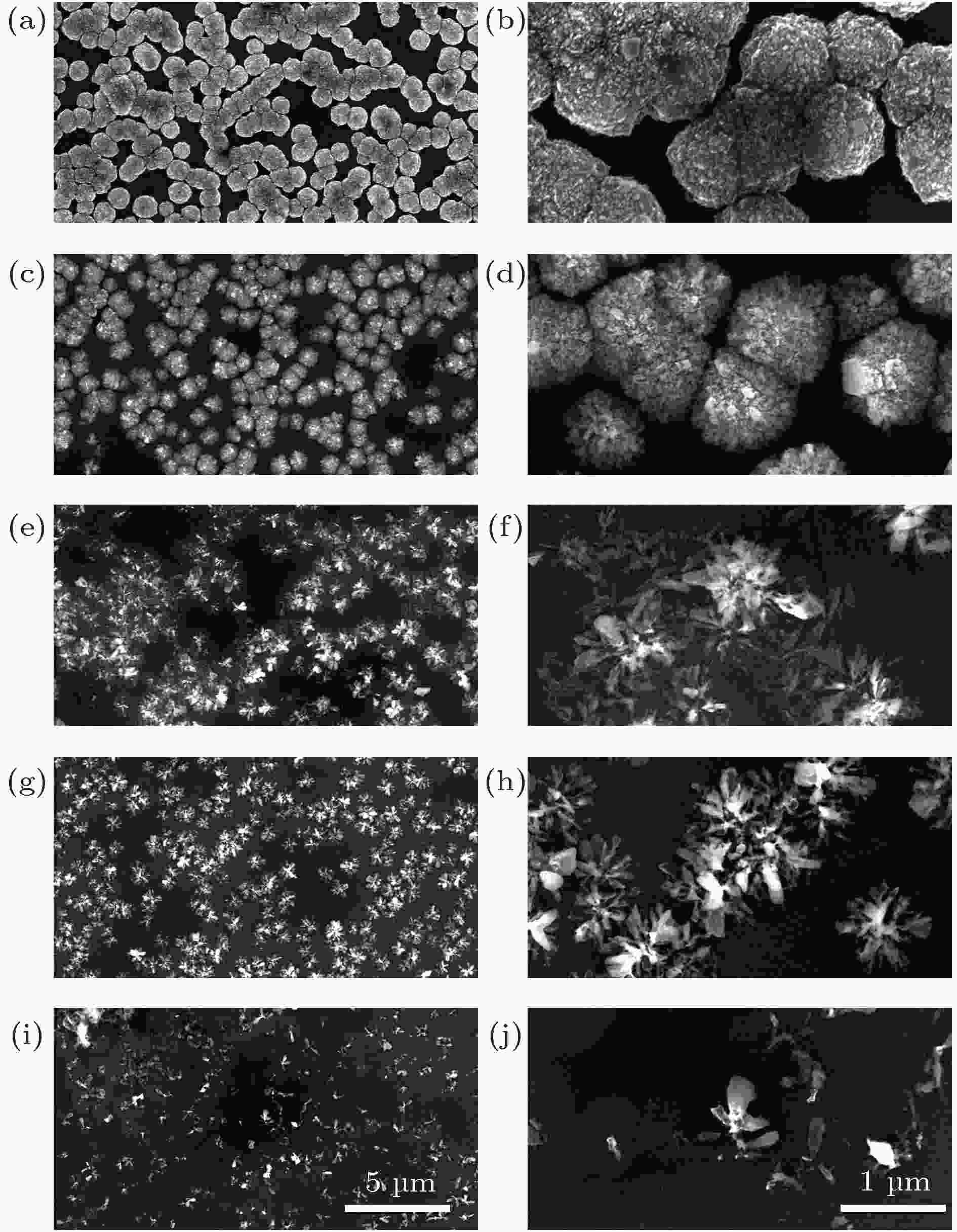
2019, 68 (16): 168101.
doi: 10.7498/aps.68.20190422
Abstract +
In order to increase the oxidation sites for enhancing the Si-V photoluminescence intensity of nanocrytalline diamond films, we prepare nanocrystalline diamond films; these films each are comprised of separated domains and oxidized for different times. Each single domain consists of nanodiamond grains with a size of larger than 100 nm and amorphous carbon. In the gaps between domains of separated domain there is formed a film that allows more sites to contact air to ensure the efficient oxidation of the film. As a result, silicon vacancy photoluminescence intensity of the separated domain forming the film is largely enhanced by about 22.7 times after oxidation. The SEM images and Raman spectra of oxidized samples show that the film contains flower-shaped diamond aggregates, each of which is comprised of radially arranged diamond grains. The mixture of nanodiamond grains and amorphous carbon fills the gaps between diamond petals. These fillers disappear after long-term oxidation, but the diamond petals stay stable. Raman spectra show that the amount of amorphous carbon largely decreases after oxidation, while diamond content apparently rises. Hydrogen is desorbed from the film after short-time oxidation according to Raman spectra, thus the quenching effect on silicon vacancy photoluminescence caused by hydrogen termination of diamond surface state is removed. Diamond petals of large size and nanodiamond grains in the fillers are both silicon vacancy photoluminescence sources of the film; the exposed diamond flats on the surface of unoxidized domains provide limited silicon vacancy photoluminescence for the film. The sufficient exposure of diamond grains after the removal of amorphous carbon leads to the significant enhancement of film’s silicon vacancy photoluminescence. With longer-time oxidation, the photoluminescence of film will slightly decrease due to the disappearance of small-sized nanodiamond grains, but the film photoluminescence almost remains stable in both intensity and property due to the stability of large-sized diamond grains. The film after 140-min oxidation remains photoluminescence enhancement, 8.3 times the photoluminescence of the unoxidized sample. The full width at half maximum of photoluminescence peak declines to merely 5.6-6.0 nm because of diamond petals’ high degree of order, which is advantageous for diamond silicon vacancy photoluminescence.

2019, 68 (16): 168501.
doi: 10.7498/aps.68.20190405
Abstract +
The static random access memory (SRAM), as a common and important high-speed storage module in modern digital circuit systems, plays an important role in improving the performances of electronic systems. The data about the total ionizing dose (TID) radiation effect of SRAM cell have not been rich in the literature so far. In this work, a novel 6-transistor SRAM cell (6T LB SRAM cell) based on L-type gate body-contact (LB) MOSFET device is designed and fabricated by 130nm silicon-on-insulator (SOI) process. The LB MOSFET follows the center-symmetric layout design of the SRAM cell, reducing the area by approximately 22% compared with the SRAM cell using the T-type gate MOSFET contact device (6T TB SRAM cell) of the same device size. The electrical performance difference between LB MOSFET and other devices is compared. Besides this, the variations of the leakage current and the reading static noise margin (RSNM) of SRAM cells based on different MOSFETs under various total ionizing doses are also investigated. The test results indicate that the LB MOS successfully suppresses the floating body effect (FBE), and that the drain-induced barrier lowing (DIBL) and drain-to-source breakdown voltage (BVds) characteristics are improved. The performance of this device is similar to that of TB MOS device, but due to the special body contact design, the former has an advantage of smaller area. Due to the use of the body contact device, the leakage current of the 6T LB SRAM cell is significantly smaller than that of the conventional floating device SRAM cell (6T FB SRAM cell), which has lower static power consumption. After 60Co-γ ray irradiation, the 700 krad(Si) radiation dose only increases the leakage current of 6T LB SRAM cell by 21.9%, which is better than 41.4% of 6T FB SRAM cell. In addition, the 6T LB SRAM cell has an RSNM value similar to that of the 6T TB SRAM cell, and this is 1.93 times higher than the that of 6T FB SRAM cell. The radiation experiment causes the butterfly curve of the 6T FB SRAM cell to be asymmetrically deformed, and the stability of the SRAM cell is deteriorated due to the TID effect. However, the test results show that when the radiation dose reaches 700 krad (Si), the RSNM value of the 6T LB SRAM cell is reduced only by 11.2%. Therefore, 6T LB SRAM cell has stable and reliable practical value.

2019, 68 (16): 168502.
doi: 10.7498/aps.68.20190510
Abstract +
In the scanning magnetic domain by using the conventional magnetic force microscopy (MFM), a laser beam reflection is used to detect the static magnetic force between probe and sample. Therefore, for the MFM, it is a challenge to directly detect the dynamic magnetic force between probe and sample under an external alternating-current (AC) magnetic field. In this study, it is proved that in an alternating magnetic force microscopy (A-MFM) a sensitive Co-GdOx superparamagnetic probe can be usedto detect the dynamic magnetic force under an external AC magnetic field (frequency ωm). In the present method, the magnetization of Co-GdOx probe is modulated by an external AC magnetic field. Collecting ωm and 2ωm signals by using the combination of phase-locked loop (PLL) and lock in amplifiers can accurately represent the static (DC, which stands for direct current) magnetic field areas (the external AC magnetic field has no effect on the magnetized status of the sample) and dynamic (AC) magnetic field areas (the external AC magnetic field changes the magnetized status of the sample) of an anisotropic Sr ferrite sintered magnet at the same time, respectively. The Sr ferrite sample is a single-domain-type magnet where magnetization mainly changes via magnetic rotation. The A-MFM method can measure the strength and identify the polarities of the static magnetic field of sample with a DC demagnetized state. By modifying the traditional tapping-lift mode into a tapping-multiply lift mode, the A-MFM by using superparamagnetic tips can measure the static and dynamic magnetic field distribution in three-dimensional (3D) space. It is proved that the static and dynamic magnetic field as a function of the distance z between probe and sample are both expressed as Hz(z) = Hz(0)·exp(–kz). The experimental data are consistent with the previous theoretical calculations. The A-MFM can be used to study the dynamic magnetization process and to evaluate the magnetic homogeneity (microstructural homogeneity) of magnetic materials.
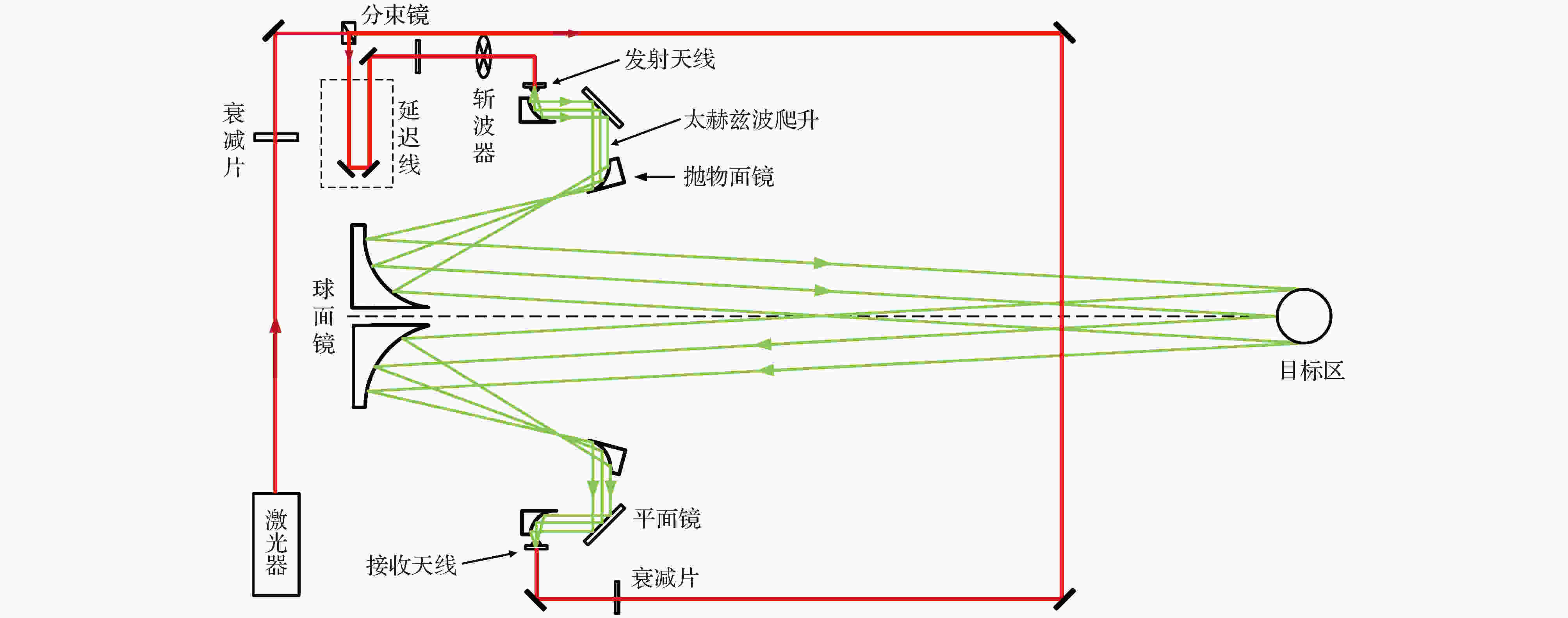
2019, 68 (16): 168701.
doi: 10.7498/aps.68.20190552
Abstract +
Terahertz time-domain spectroscopy technology has a wide range of applications in security inspection, nondestructive testing, biomedical, etc. But its application to target characteristics has been under debates, because there exist so many differences between terahertz continuous wave and ultra short pulse wave (single pulse width about 1 ps). For investigating the problem of quantitatively measuring the terahertz radar cross section, in this paper, a terahertz time domain spectroscopy scattering measurement system is built based on the technology of terahertz time domain spectroscopy. After system optimization and error minimization of location and system, time domain echoes of targets, such as sphere, disk, cylinder and complex targets, are measured. After the process of fast Fourier transformation and calibration, radar cross sections of the above-mentioned targets in a frequency range of 0.2–1.6 THz are calculated. Furthermore, the surface integral equation method and multilevel fast multipole algorithm are used to simulate the radar-cross section (RCS) results. The measured radar cross section results are compared with the simulations, and their error is less than 3 dB. The error arises mainly from the location and uneven distribution of terahertz wave on quiet zone. Generally, it is acceptable though there is still much work to do. The accuracy of RCS measurement of terahertz time domain is varified. All those are progressing in terahertz time domain spectroscopy technology used in target characteristics. Moreover, the methods of improving dynamic range in high frequency and enlarging quiet zone are the focus of follow-up studies.
SPECIAL TOPIC—In commemoration of the 100th anniversary of the birth of Kun Huang
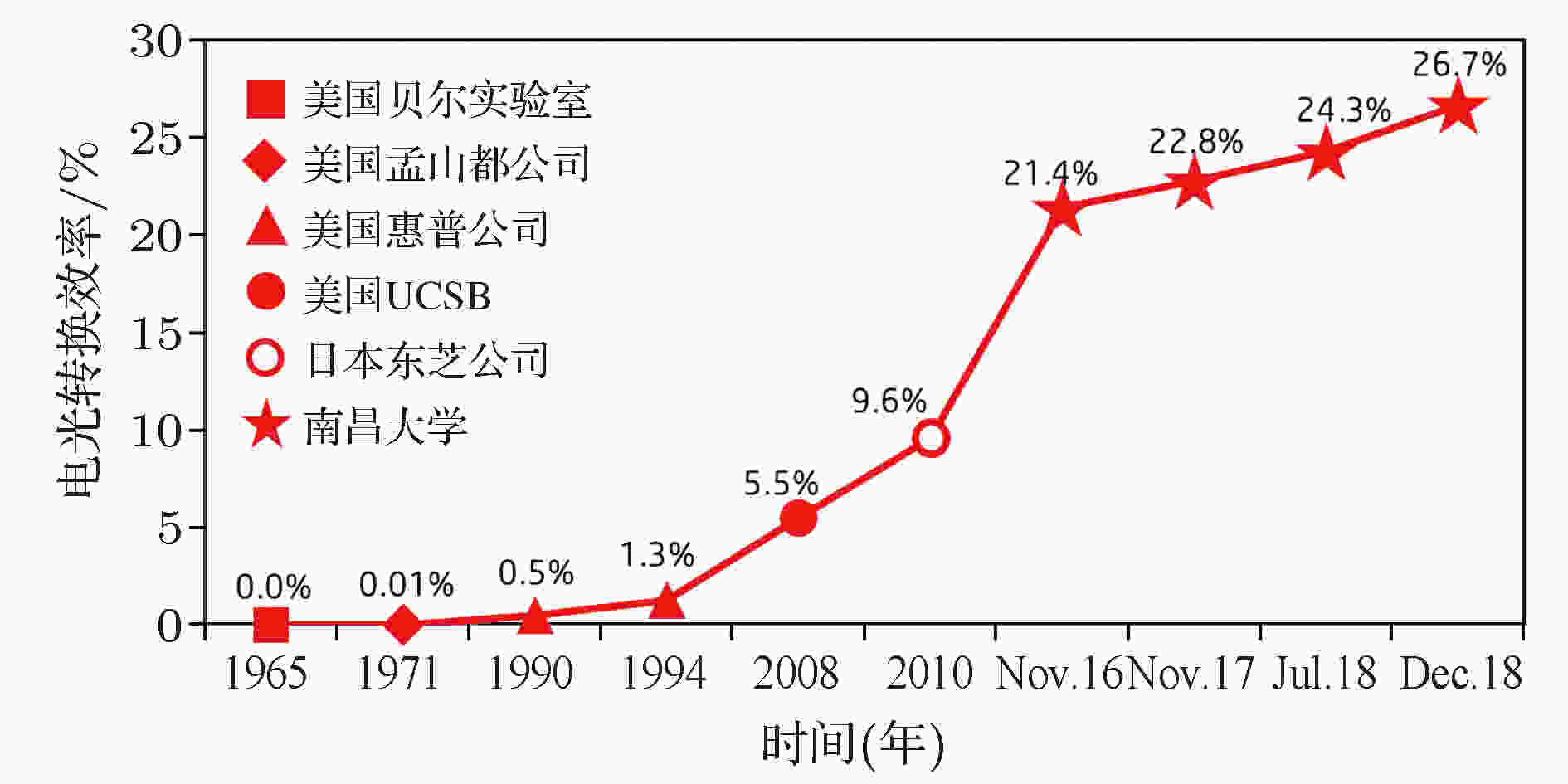
2019, 68 (16): 168503.
doi: 10.7498/aps.68.20191044
Abstract +
The development of semiconductor light-emitting diode (LED) in the visible emission range is very unbalance, as the power efficiency of yellow LED is far below other colors. Based on the GaN/Si technology, the authors and his team made a systematic research from the aspect of material growth, chip fabrication, device physics and equipment design, resolved the problems of epi-film cracking, high dislocation density, large strain in quantum well (QW), phase separation in QW, low QW growth temperature, low hole concentration, light absorption by substrate and light blocking by electrode, successfully made a breakthrough in fabricating efficient yellow LED. The yellow LED chip achieves a power efficiency of 26.7% at 20 A/cm2 with 565 nm wavelength and efficacy of 164 lm/W, and the power efficiency goes up to 42.8% at 1 A/cm2 with 577 nm wavelength and efficacy of 248 lm/W. New LED light source with multi-colors and without phosphor was developed based on the efficient yellow LEDs, opened up a new direction of pure LED healthy lighting.

2019, 68 (16): 166801.
doi: 10.7498/aps.68.20191074
Abstract +
Semiconductor heterojunctions play a crucial role in exploring novel physics and developing advanced devices. Due to the characteristic electronic band structure, such as the narrow bandgap and the large spin-orbital interaction, the Ⅳ-Ⅵ compound semiconductor heterojunctions are not only of great importance to infrared detectors, but also arouse extensively concern in the frontier fields of physics, like topological insulators (TIs) and spintronics. Most excitingly, the two-dimensional electron gas (2DGE) with high electron density and high mobility is revealed at the interface of the typical Ⅳ-Ⅵ compound semiconductor CdTe/PbTe heterojunction, the formation of which is attributed to the unique twisted interface of the Ⅳ-Ⅵ compound semiconductor heterojunctions. Further researches demonstrate that the 2DEG system boasts prominent infrared photoresponse and is of Dirac fermion nature. This review presents the major progress in Ⅳ-Ⅵ compound semiconductor heterojunction 2DEG in the past decades. First, the formation mechanism of the twisted heterojunction 2DEG is discussed based on both theoretical and experimental results. By molecular beam epitaxy the novel lattice-mismatch heterostructure CdTe/PbTe with sharp interface was obtained and first-principle calculations revealed that the alternately changed atomic layer spacing played a crucial role in the formation of 2DEG. High resolution transmission electron microscope image of the interface clearly demonstrated the twisted interfacial structure and showed that the interfacial Te-sharing bonding configuration provided the excessive electrons. Second, we show the transport properties of the 2DEG under the condition of low temperature and high magnetic field, and the unambiguous π Berry phase of quantum oscillations indicate that the 2DEG is of Dirac fermion nature and demonstrate its potential for realizing two-dimensional TI and spintronic device. Moreover, the 2DEG exhibits quite high mobility, making it candidate for high electron mobility transistor. At last, the high-performance mid-infrared photodetector is displayed, which is built based on the typical Ⅳ-Ⅵ compound semiconductor CdTe/PbTe heterojunction. The most exciting feature of the detector is that it is able to achieve high-speed response with satisfying detectivity while working at room temperature, which could be a complementation to state-of-art mid-infrared photodetectors. In summary, the Ⅳ-Ⅵ compound semiconductor heterojunctions are of great significance not only in fundamental physics but also in device applications, and this review could provide the researchers with the main results in the field.
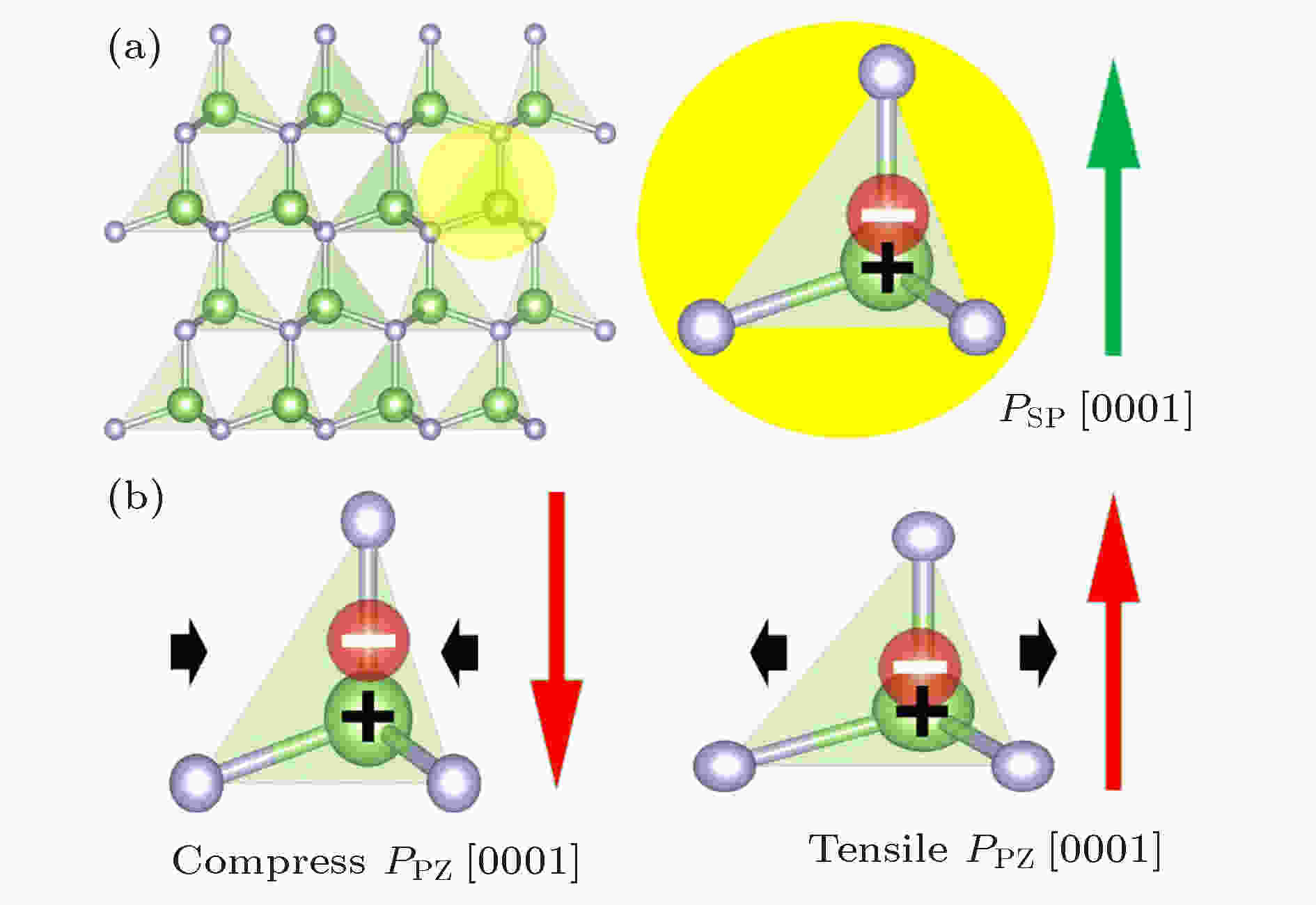
2019, 68 (16): 167101.
doi: 10.7498/aps.68.20191239
Abstract +
The manipulation of electronic structures of conventional semiconductors remains the key issue of modern semiconductor physics and devices. Compare to limited modulation of semiconductors by conventional gate technique, we theoretically demonstrate that, polarized interfaces can generate a strong built-in electric field (about 10 MV/cm) in both polar and non-polar semiconductors, and the polarized interfaces can tune the band gaps in a wide range (approximately 0—2 eV), and significantly enhances the Rashba spin-orbit coupling strength as well. In this paper, we introduce polarized interfaces in polar semiconductor InN and non-polar semiconductor Ge, and generate topological insulator phases by polarized interfaces. The polarized interface is compatible with conventional semiconductor fabrication techniques and shows interesting physics and potential optoelectronic applications.
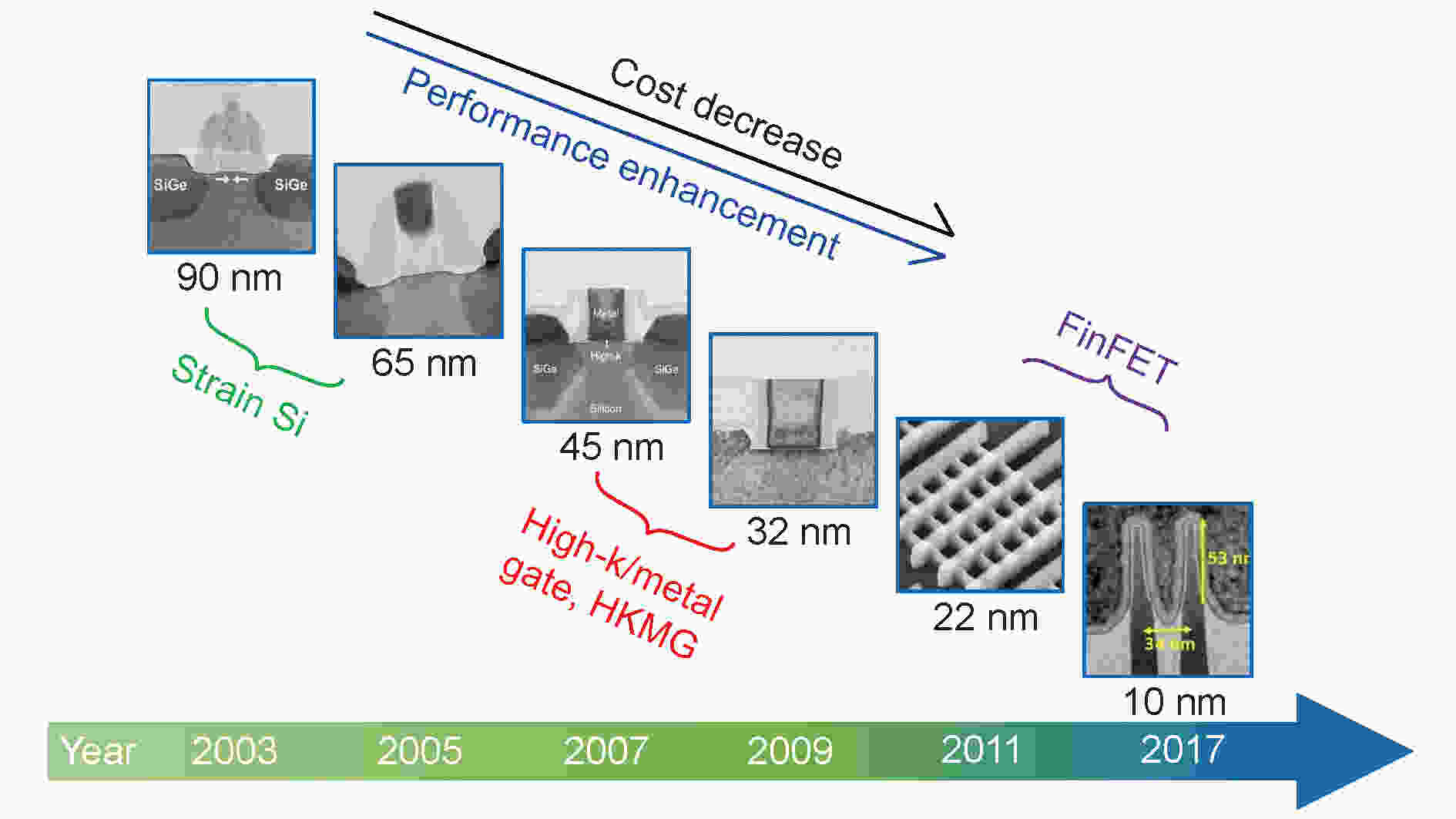
Progress of the study on carrier scattering mechanisms of silicon/germanium field effect transistors
2019, 68 (16): 167301.
doi: 10.7498/aps.68.20191146
Abstract +
As the feature size of Metal-Oxide-Semiconductor Field Effect Transistors (MOSFETs) continues to decrease, large numbers of new problems appear. Techniques such as strain project, new channel materials and new device structures are considered by academics and industry to be effective ways to continue to improve device performance. In this paper, the scattering mechanism of carriers in the device channel is studied from three aspects: strain technique, new channel material and new structure device: (1) strain technique: Biaxial tensile strain can change carrier distribution among different energy levels, which affects Coulomb scattering and Coulomb mobility. Furthermore, from the TEM image, it is found that biaxial tensile reduces the channel surface roughness for Si nMOSFET, leading an enhancement of electron mobility. However, no such similar phenomena were observed in pMOSFET. Based on this, a new method for calculating the mobility of MOSFET surface roughness scattering using TEM image has been proposed. (2) New channel material: In the germanium (Ge) transistors with different crystal faces, the scattering mechanisms of electron under high field conditions are different. The phonon scattering dominates the Ge(100) transistor, while the surface roughness scattering dominates the Ge(110), (111) transistors. This result is quite different from Si MOSFET. Therefore, a unified model for the scattering mechanism of electron in Ge nMOSFET has been proposed. In SiGe transistors, alloy scattering mainly play a role in the region with relatively small effective electric field (Eeff). The strength of alloy scattering would be weakened in high field and could be decreased by reducing the thickness of SiGe layer. (3) New structure devices: In ultra-thin body germanium (GeOI) transistors, carrier transport is influenced by high- k /channel interfaces, as well as Ge channel/buried oxide (BOX) interface. As the Ge layer thickness decreases, carrier distribution is closer to the interfaces, which intensifies Coulomb scattering and surface roughness scattering. As a result, the mobility in GeOI transistor decreases as the thickness scaling. In addition, the distribution of electron in different energy valleys changes with the thickness decrease in Ge layer, which affects the scattering of electrons. When the Ge film is lower than 10 nm, a part of electron in the L valley will move to the Γ valley, causing the decrease of electron effective mass and increasing the electron mobility.

2019, 68 (16): 167502.
doi: 10.7498/aps.68.20191114
Abstract +
Due to the potential applications for spintronics devices, diluted ferromagnetic semiconductors (DMS) have received extensive attention for decades. However, in classical Ⅲ–Ⅴ based DMS material, such as (Ga,Mn)As, heterovalent (Ga3+, Mn2+) doping results in lack of individual control of carrier and spin doping, and seriously limited chemical solubility. The two difficulties prevent furtherincrease of the Curie temperature of the Ⅲ–Ⅴ based DMS. To overcome these difficulties, a series of new types of DMS with independent spin and charge doping have been synthesized, such as Ⅰ–Ⅱ–Ⅴ based LiZnAs and Ⅱ–Ⅱ–Ⅴ based (Ba,K)(Zn,Mn)2As2. In these new materials, isovalent (Zn,Mn) substitution is only spin doping, while charge is independently doped by heterovalentsubstitution of non-magnetic elements. As a result (Ba,K)(Zn,Mn)2As2 obtains the reliable record of Curie temperature (230 K) among DMS in which ferromagnetic ordering is mediated by itinerate carriers. In this review, we summarize the recent development of the new DMS materials with following aspects: 1) the discovery and synthesis of several typical new DMS materials; 2) physical properties studies with muon spin relaxation and in-situ high pressure techniques; 3) single crystal growth, Andreev reflection junction based on single crystal and measurements of spin polarization.
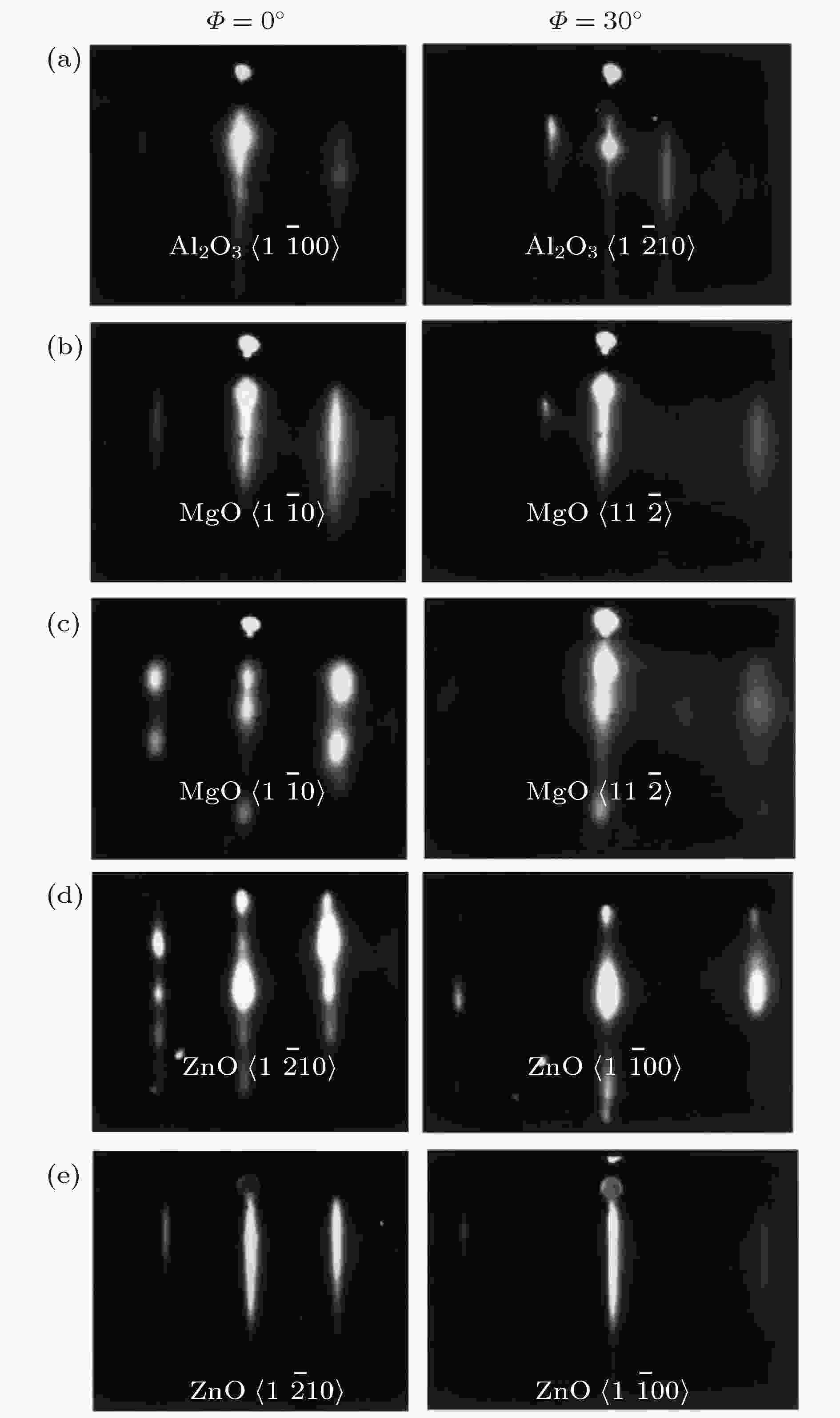
2019, 68 (16): 167802.
doi: 10.7498/aps.68.20191043
Abstract +
II-oxides wide-bandgap semiconductor, including the beryllium oxide (BeO), magnesium oxide (MgO), zinc oxide (ZnO), have large exciton binding energy (ZnO 60 meV, MgO 80 meV), high optical gain (ZnO 300 cm–1) and wide tunable band gap (3.37 eV ZnO, MgO 7.8 eV, BeO 10.6 eV), which are the advantages of achieving low-threshold laser devices in the ultraviolet wavelength. It is also one of the important candidates to replace the traditional gas arc lamp (such as mercury lamp, deuterium lamp, excimer lamp, xenon lamp etc.) as the source of deep ultraviolet and even vacuum ultraviolet. Although, during the past decades, the ZnO-based pn homojunction devices have made great progress in the near-UV electroluminescence, but as the band gap broadens, the acceptor (or donor) ionization energy becomes higher (On the order of hundreds meV), which causing the room temperature equivalent thermal energy (26 meV) cannot make the impurities ionizing effectively. In addition, the self-compensation effect in the doping process further weakens the carrier yield. These above drawbacks have become the bottleneck that hinders II-oxides wide-bandgap semiconductor from achieving ultraviolet laser devices and expanding to shorter wavelengths, and are also a common problem faced by other wide-bandgap semiconductor materials. The regulation of the electrical and luminescent properties of materials often depends on the control of critical defect states. The rich point defects and their combination types make the II-oxides wide-bandgap semiconductors an important platform for studying defect physics. For the identification and characterization of specific point defects, it is expected to discover and further construct shallower defect states, which will provide a basis for the regulation of electrical performance. In this paper, recent research results of II-oxides wide-bandgap semiconductors will be described from three aspects: high-quality epitaxial growth, impurity and point defects, p-type doping and ultraviolet electroluminescence. Through the overview of related research works, II-oxides wide-bandgap semiconductors are clarified as deep ultraviolet light sources materials. Meanwhile, indicates that the key to the regulation of electrical performance in the future lies in the regulation of point defects.
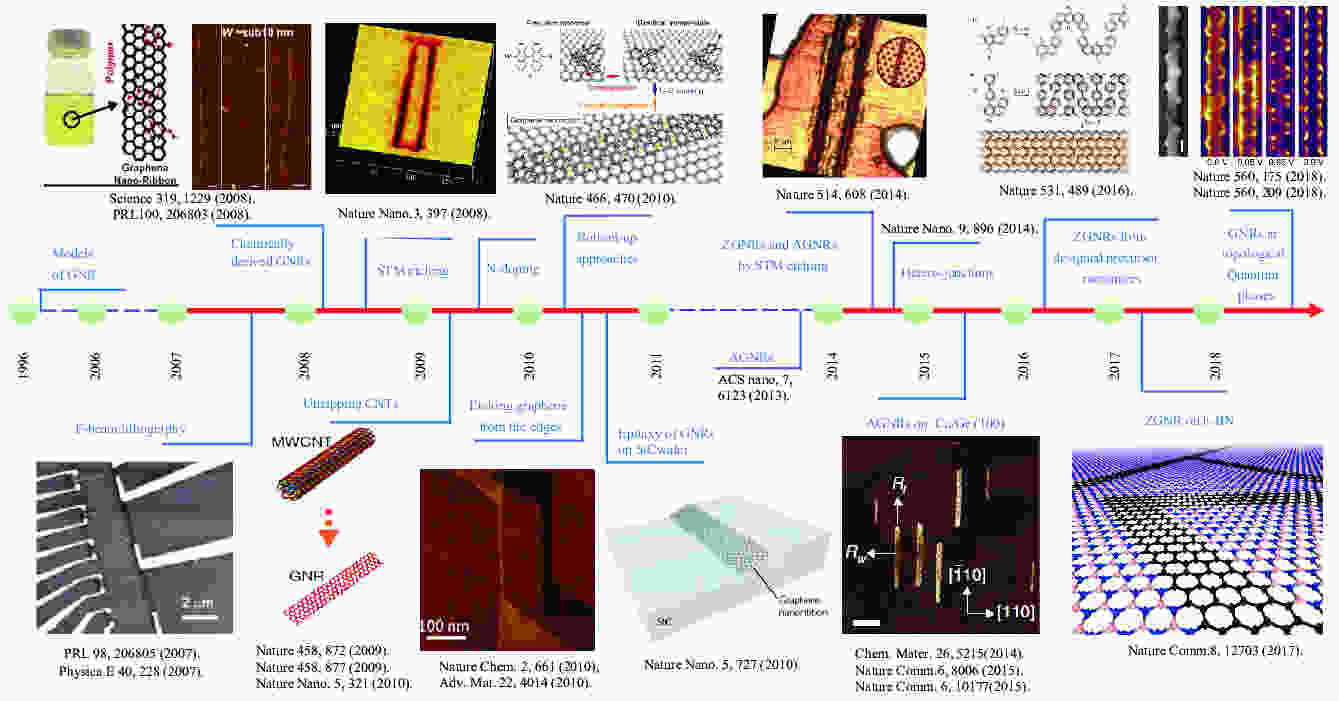
2019, 68 (16): 168102.
doi: 10.7498/aps.68.20191036
Abstract +
Graphene, as a typical representative of the two-dimensional material family, has received a wide attention due to its excellent physical and chemical properties. Graphene nanoribbon (GNR) is graphene in a width of several to a few tens of nanometers. GNRs not only inherit most of the excellent properties of graphene, but also have their own specific properties such as band gap opening and spin-polarized edge states, which make it the potential candidate in graphene based electronics in the future. Hexagonal boron nitride (h-BN), which has similar lattice constant with graphene, normally serves as an ideal substrate for graphene and GNRs. It can not only effectively preserve their intrinsic properties, but also benefit for the fabrication of electrical devices via popular semiconductor processes. In this paper, we reviewed the development history of research of graphene and GNRs on h-BN in recent years. The recent progress of physical properties is also discussed. In order to realize the large scale production of graphene and GNRs on h-BN, high quality h-BN multilayer is necessary. In addition, recent progresses about h-BN preparation methods are presented, and the progresses could pave the way for the further application of GNRs in the electronics. Finally, the research direction of graphene and GNRs on h-BN in the future is discussed.
ATOMIC AND MOLECULAR PHYSICS

2019, 68 (16): 163201.
doi: 10.7498/aps.68.20191002
Abstract +
Polarized photodetection technology has good application value in the fields of remote sensing imaging, environmental monitoring, medical detection and military equipment. Polarized photodetectors based on low-dimensional materials can use the natural anisotropy of materials to detect polarized information. Some two-dimensional materials have strong in-plane anisotropy due to their low-symmetrical crystal structure, such as black-phosphorus, black-arsenic, ReS2, GaTe, GeSe, GeAs, and TiS3. These anisotropic two-dimensional materials are appropriate for the working medium of polarized photodetectors. Numerous researchs focused on polarized photodetectors with different materials and device structures and our works are introduced. Polarized photodetectors based on such low-dimensional materials have realized a broadband photodetection, including ultraviolet, visible, and infrared lights.
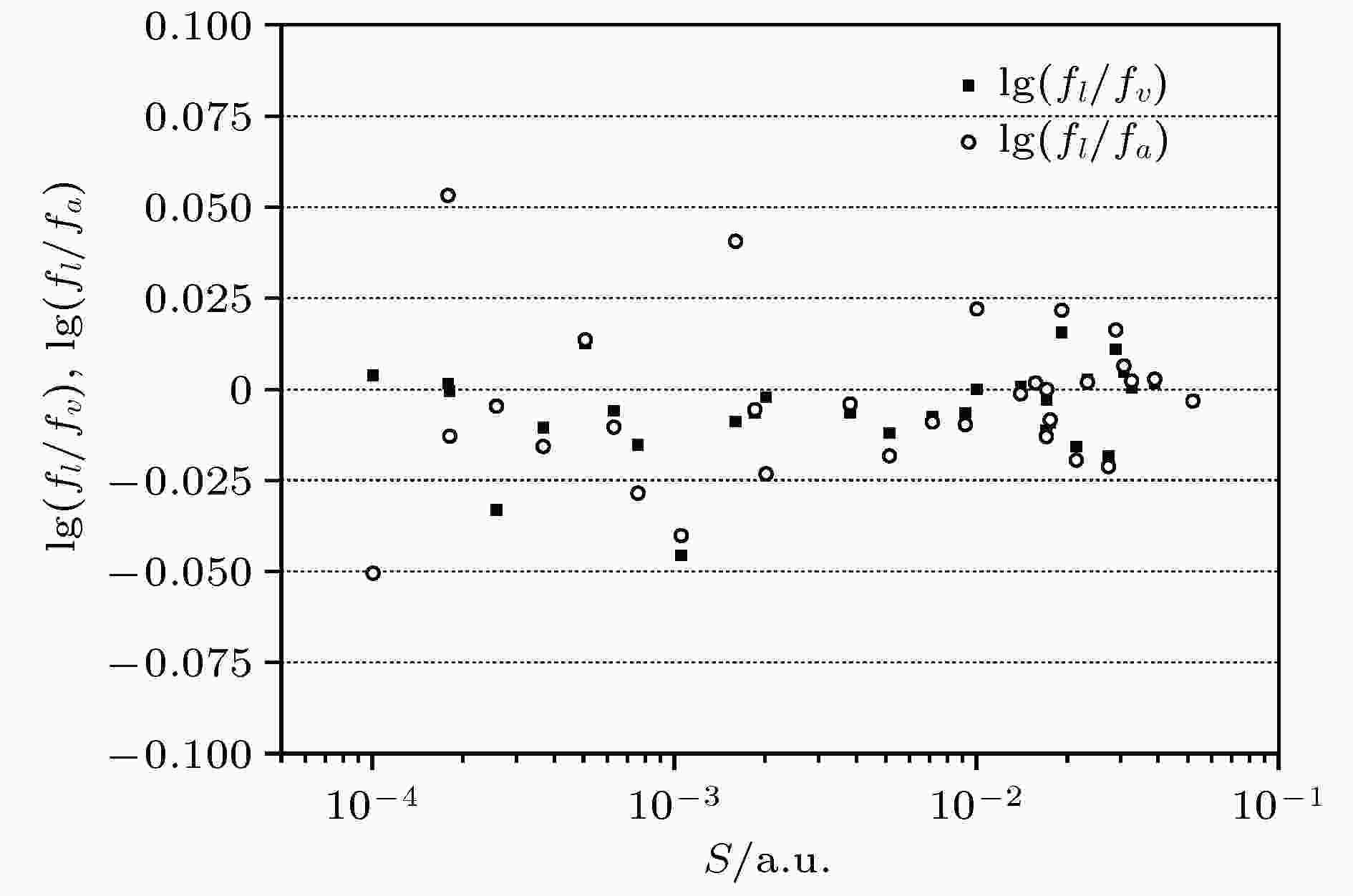
2019, 68 (16): 163101.
doi: 10.7498/aps.68.20190481
Abstract +

2019, 68 (16): 163601.
doi: 10.7498/aps.68.20190544
Abstract +
MgO is a typical ionic compound with strong polarity. Hydrogen absorbed by MgO materials subjected to an external electric field is a potential method to store hydrogen. However, the method requires an extremely high intensity of electric field, which is difficult to achieve. Therefore, reducing field intensity has become a key problem in the field of hydrogen storage. In this paper, the hydrogen storage properties of an (MgO)4 cluster under an external electric field are investigated. The results show that under the external electric field, (MgO)4 keeps the frame of cube structure but with little distortion, which implies that (MgO)4 cluster can sustain the strong electric field. The (MgO)4 is also polarized by the external electric field and its dipole momentum increases to 1.67 and 3.33 Debye when the field intensity is 0.005 and 0.010 a.u., respectively. H2 can be adsorbed on a single Mg/O atom: H2 is adsorbed at lateral position of Mg atom, while at the top of O atom. The adsorption strength is substantially enhanced under an external electric field. Under only 0.010 a. u. of electric field, the adsorption energy of H2 on the Mg or O atoms increases from –0.118 eV to –0.225 eV or from –0.060 eV to –0.150 eV, respectively. The electric field required is significantly lower than that of a large (MgO)9 cluster. This result suggests that reducing the size of material is a possible method toreduce the electric field for hydrogen storage in polarizable materials. The weak interaction between H2 and (MgO)4 is analyzed by the quantum theory of atoms in molecules. The results indicate that under an electric field, (MgO)4 and H2 are effectively polarized, and the electrostatic interaction between them is subsequently enhanced. Meanwhile, the small cluster is easily polarized because most of the atoms are in the surface and have low coordination. Therefore, the electric field required can be substantially reduced. Moreover, (MgO)4 adsorbs 16 H2 molecules at most. The corresponding mass density of hydrogen storage reaches 16.7 wt%, indicating that (MgO)4 can be used as a hydrogen storage material under an electric field.
CONDENSED MATTER: STRUCTURAL, MECHANICAL, AND THERMAL PROPERTIES
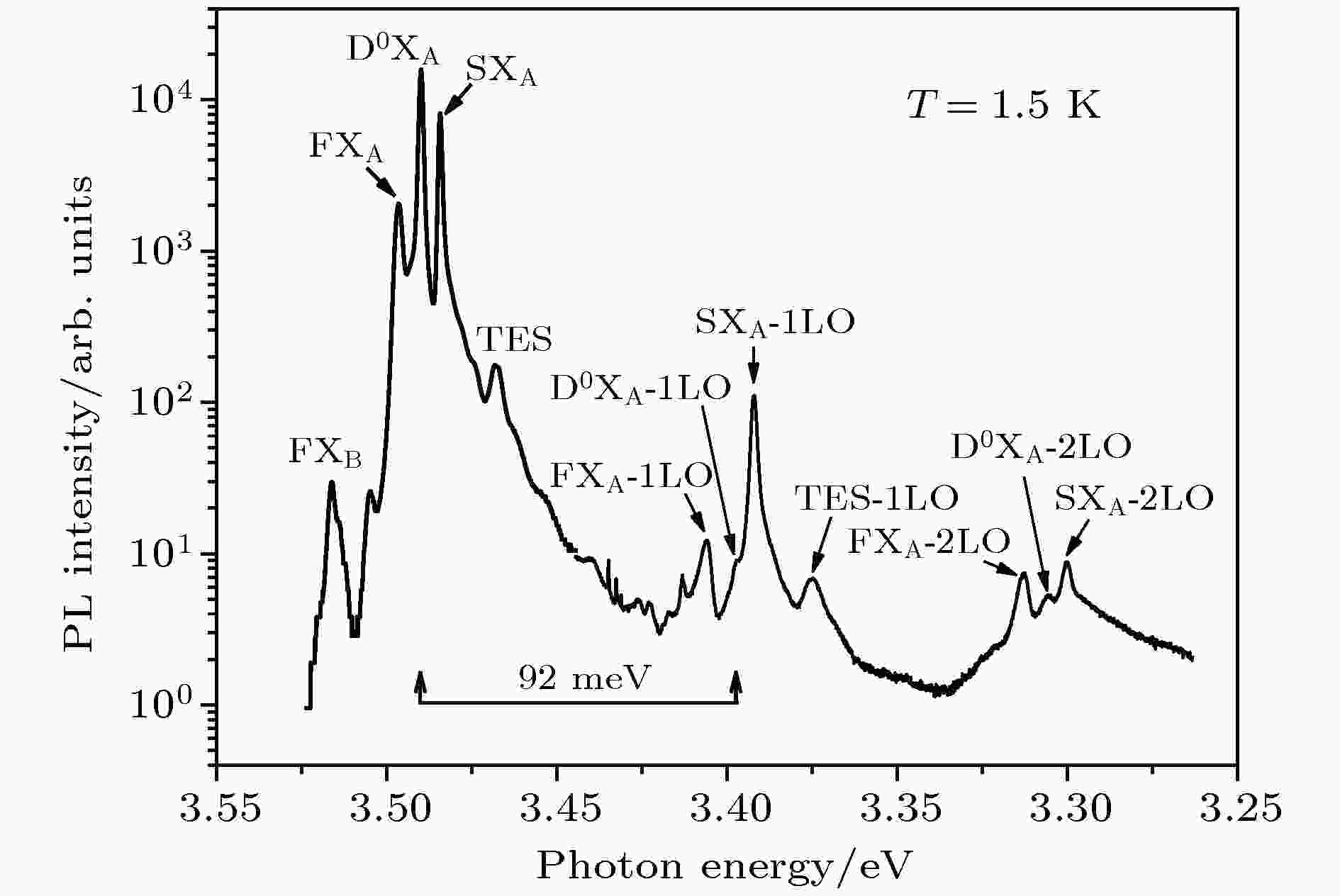
2019, 68 (16): 166301.
doi: 10.7498/aps.68.20191073
Abstract +
Huang and Rhys published a quantum theoretical treatment to the light absorption in F-centre in solids, which has been widely recognized as the first detailed quantum-mechanical calculation. In the Huang-Rhys’s seminal theoretical treatment, they derived a dimensionless factor to characterize electron-phonon coupling strength which was named later as Huang-Rhys factor. Since then, Huang-Rhys factor has been generally accepted. In this short review, the physical nature of Huang-Rhys factor and several application examples in solids are introduced and presented in memory of the hundredth anniversary of Prof. Kun Huang. Due to limited publication space and my personal understanding on Huang-Rhys factor, only several cases including GaN, 2D WS2 monolayer semiconductor, inorganic CsPbBr3 perovskite nanosheets and NV centers in diamond, in which the extremely-weak and medium strong coupling between electron (exciton) and phonon occur, are discussed in this short review.

2019, 68 (16): 166101.
doi: 10.7498/aps.68.20190594
Abstract +
The static and dynamic mechanical characteristics of carbon nanotubes with double and multiple vacancy defects are simulated by the molecular dynamics method. Firstly, the effects of diatomic and polyatomic vacancy defects on the quasi-static mechanical properties of carbon nanotubes are discussed. Then, the effects of defects and axial pre-stress on the dynamics of C60 molecular oscillation in carbon nano-peapods are discussed. The results show that the ultimate stress, ultimate strain and elastic modulus of carbon nanotube containing different types of diatomic vacancies are significantly reduced as compared with those of non-defective carbon nanotubes. When the carbon nanotubes have many defective atoms and the defects are connected together to form a crack, the axial compressive properties of the carbon nanotubes are greatly reduced. Compared with the circumferential development of cracks, the cracks along the axis greatly reduce the compressive capacity of carbon nanotubes, which is similar to that of shell models with cracks. The oscillation frequency of C60 molecular in defective carbon nano-peapods is affected by the number of missing atoms. The single vacancy defect increases the oscillation frequency of C60 molecule, while with the further increase of vacancy number, the oscillation frequency of C60 molecule decreases gradually. When the defective carbon nano-peapod has axial tensile or compressive pre-stress, the oscillation of the C60 molecule is affected not only by the defects, but also by the axial pre-stress, which makes the oscillation of C60 molecule more complicated.
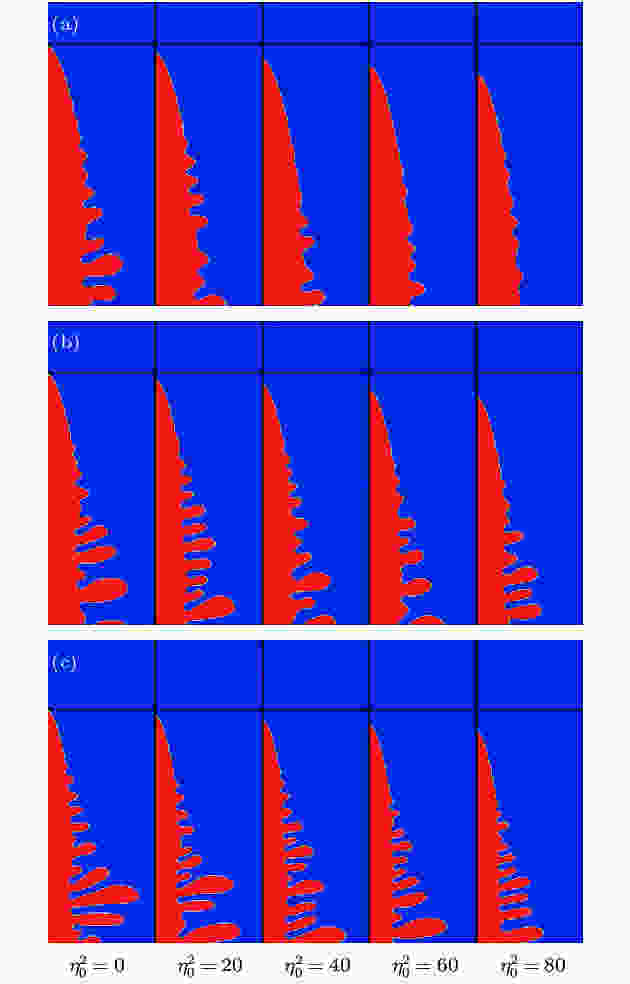
2019, 68 (16): 166401.
doi: 10.7498/aps.68.20190603
Abstract +
Solute diffusion is an important process that determines the dendrite growth during solidification. The theoretical model generally simplifies the solute diffusion coefficient in liquid phase into a constant. Nevertheless, the composition of the boundary layer changes greatly in the solidification process, the diffusion coefficient will no longer be a constant and is dependent on concentration. In this paper, the quantitative phase field model is used to simulate the effect of concentration-dependent diffusion coefficient on dendrite growth in directional solidification. In the model, the concentration-dependent diffusion process is investigated by coupling the concentration-dependent diffusion coefficient in the liquid solute diffusion equation. A series of simulation results confirms that the concentration-dependent diffusion process has a significant effect on the dendrite growth. The results show that the increase of the coupling intensity of solute concentration will enhance the diffusion of solute in the mushy zone between primary dendrites to the dendrite tip, resulting in the increase of solute enrichment at the dendrite tip, thereby increasing the tip undercooling. The variation of diffusion coefficient in liquid phase has little effect on the tip radius of dendrite, and the simulation results are in good agreement with those from the theoretical model. Moreover, the amplitude of dendritic side branches decreases with the increase of solute diffusion coefficient. In the study of dendrite arrays, it is found that the concentration-dependent diffusion coefficient increases the primary spacing and reduce the tip position. The results of this study indicate that for a system with a concentration-dependent coefficient significantly, the effect of concentration-dependent diffusion on tip undercooling and side branches should be considered in the quantitative and experimental verification of the existing model.
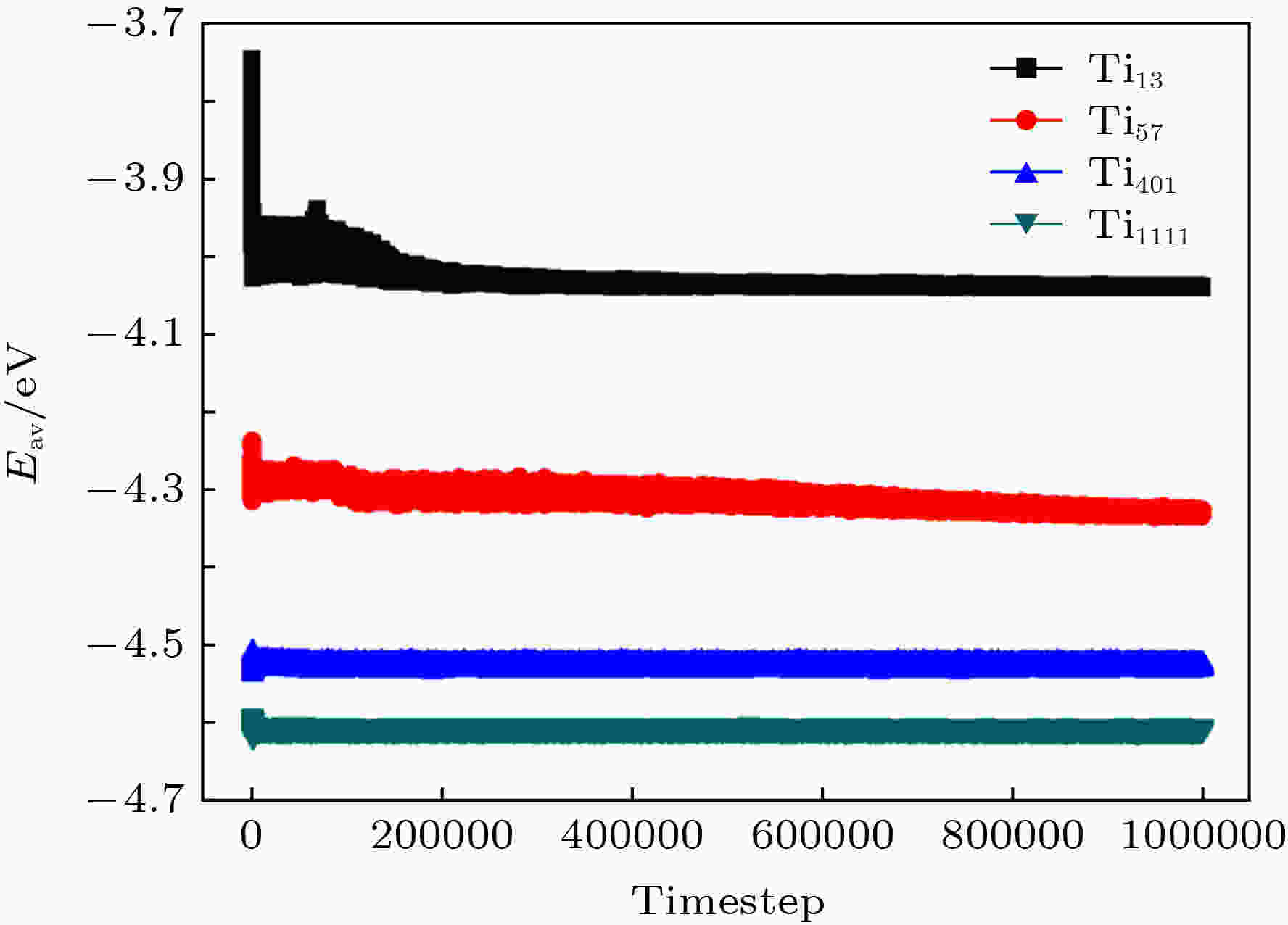
2019, 68 (16): 166402.
doi: 10.7498/aps.68.20190228
Abstract +
Titanium (Ti) has many advantages including high specific strength, low density, and biocompatibility, and is an excellent option for biomedical implant applications. Traditionally manufacturing processes have great difficulties in processing the hexagonal α-Ti with complex geometries, which would be transformed into the BCC β-Ti at high temperatures. Additive manufacturing (AM) or metal three-dimensional(3D) printing has made it possible to accurately fabricate Ti products with complex morphology. As nanoparticles have been used in the AM processing, an interesting issue arises naturally to understand packing changes of Ti particles with nanometer size during heating and cooling. The information provides the possibility in understanding the processing-structure-property-performance relations in the AM processes with the intent of producing the desirable microstructural features, and thus achieving the mechanical properties comparable or even superior to the conventionally manufactured parts. Because of lacking appropriate experimental techniques, computational approach becomes a good option to obtain various static and dynamic properties of metals reliably, in bulk or surface configurations. On a nanoscale, as the number of atoms in one particle increases, the computational cost increases exponentially and the data complexity increases correspondingly. Molecular dynamics (MD) simulation is a well-established technique to characterize microscopic details in these systems involving combined behaviors of atom movements and locally structural rearrangements. In this paper we conduct the simulations within the framework of embedded atom method provided by Pasianot et al. to study packing transformations of Ti nanoparticles upon heating and cooling on an atomic scale. Based on the calculation of the potential energy per atom, pair distribution function, pair analysis, and the specific heat capacity, the results show that the particle size and temperature changes play key roles in the packing transformations. Small size particles preferentially form icosahedral geometries. As the particle size increases, particles can hold their HCP packing at room temperature. Upon heating, the structural transformation from HCP to BCC occurs in these large size particles, and there coexist the HCP structure and the BCC structure. At a high temperature, these particles present the melting behavior similar to that of the bulk phase. When the molten particles are cooled, the atoms in the particles undergo melting-BCC-HCP structural transition, and the freezing temperature lags behind the melting temperature. The simulations provide an estimate of the critical size, and are applicable to classical theory for melting the Ti particles.
CONDENSED MATTER: ELECTRONIC STRUCTURE, ELECTRICAL, MAGNETIC, AND OPTICAL PROPERTIES
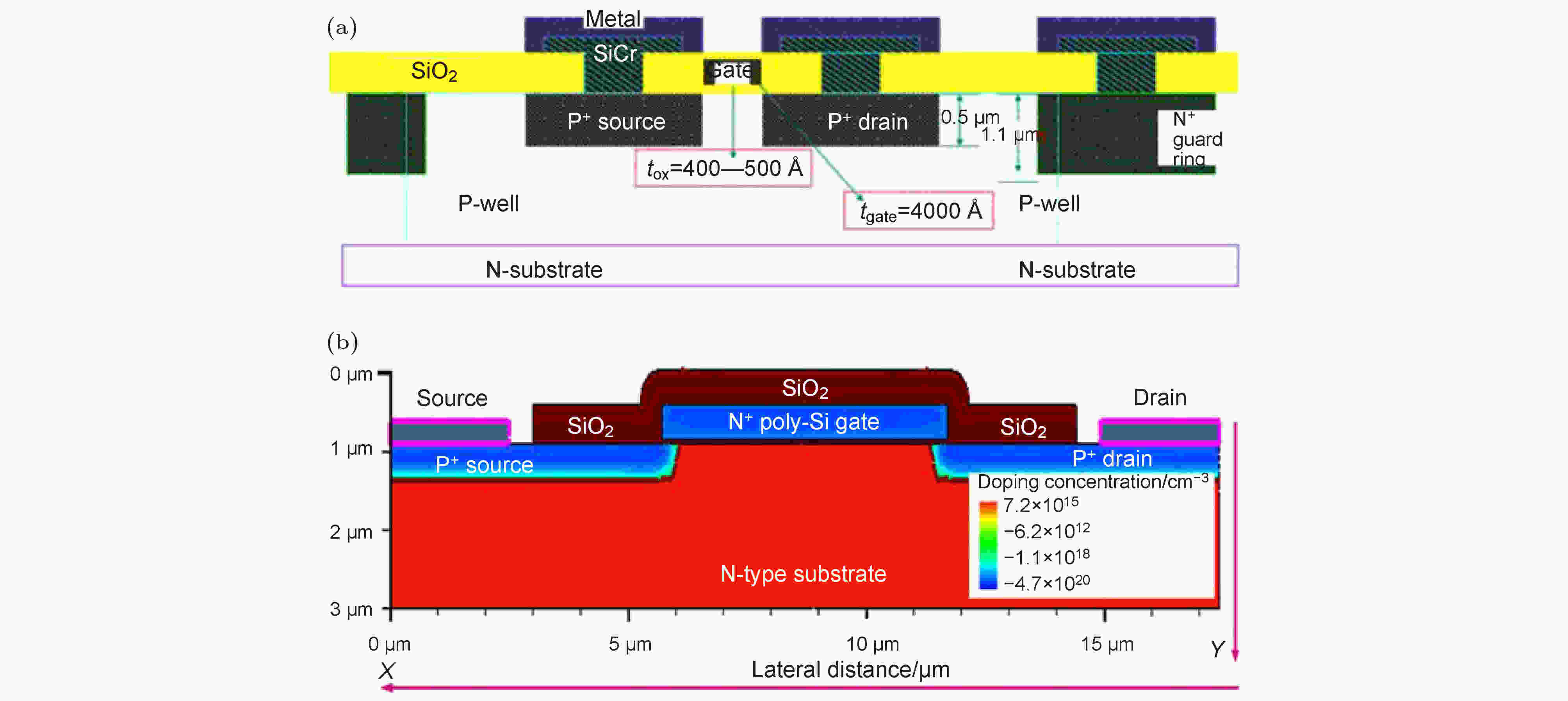
2019, 68 (16): 167803.
doi: 10.7498/aps.68.20191004
Abstract +
Photonic interconnects have potentials to break increasingly severe energy efficiency and bandwidth density bottlenecks of electrical interconnect in scaled complementary metal oxide semiconductor (CMOS) integrated circuits, leading to the emergence of optoelectronic integrated circuits (OEICs) that utilize electronic and photonic devices together in a synergistic way to achieve better performance than those based on pure electronic device technology. By reviewing the progresses of Si-based light-emitting device, the schematic of MOS-like light source integrated with waveguides and the following photodetector is analyzed for its availability. It is believed that on-chip optical interconnects could be achieved by standard CMOS technology successfully with the speed as fast as the velocity of light, supplying propulsions for nest-generation OEICs.
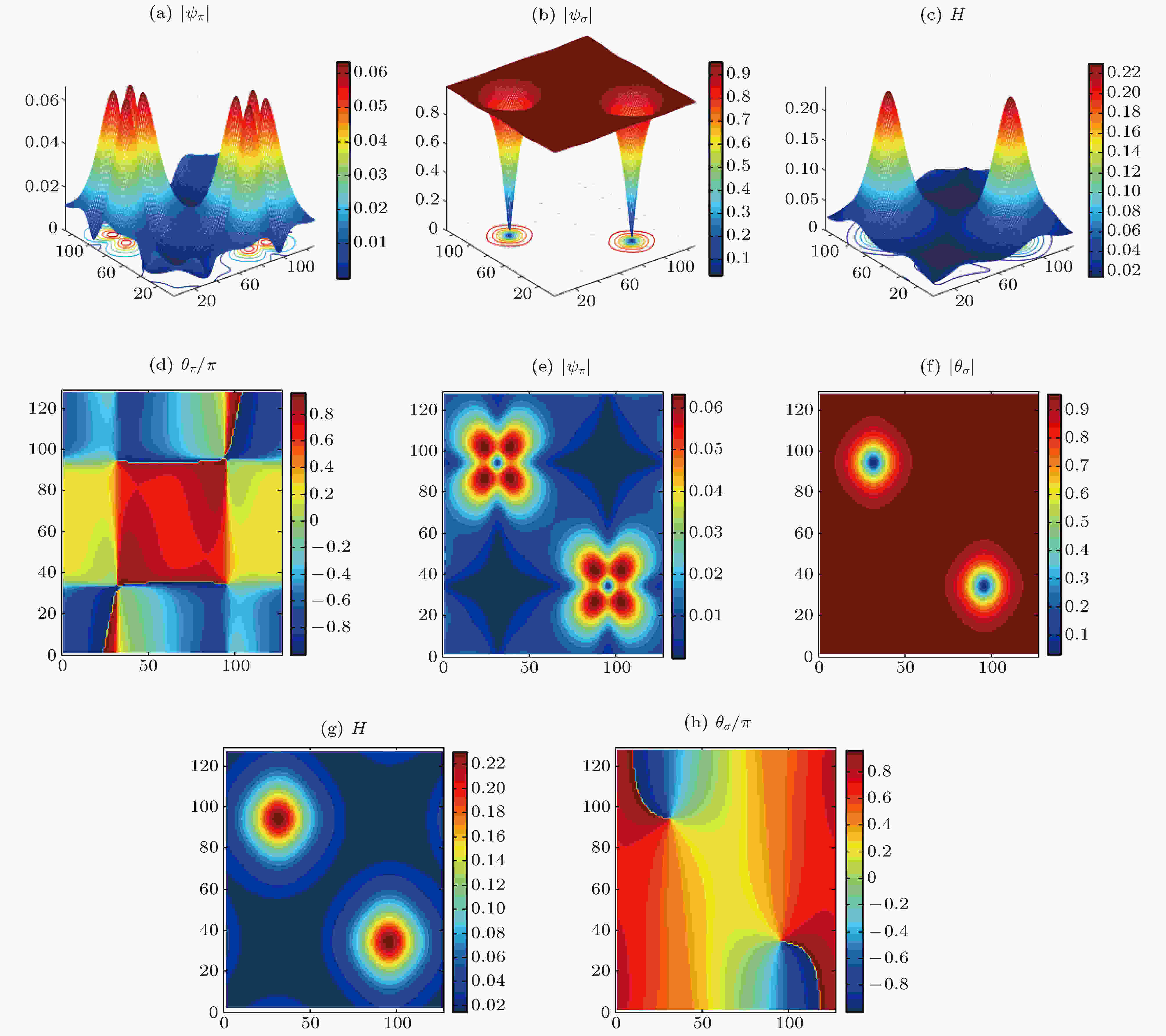
EDITOR'S SUGGESTION
2019, 68 (16): 167401.
doi: 10.7498/aps.68.20190445
Abstract +
We investigate the interband coupling induced odd-frequency pairing state by solving the microscopic Ginzburg-Landau model for the two band superconductor magnesium diboride (MgB2). It is found that the interband coupling can induce a new domain structure and a heliacal spontaneous magnetic vortex-antivortex pair around the cyclical domain wall, which breaks down spin-rotational symmetry and supports a time-reversal violating bound state, allowing the coexistence of spin-singlet and spin-triplet state close to the spontaneous vortex core. The odd-frequency spin-triplet even parity pairing state occurs since a successive operation in the orbital parity (P) and the time-reversal (T) obeys PT = + 1(–1) for spin-singlet (spin-triplet) pairing amplitude. A general phase diagram is presented.
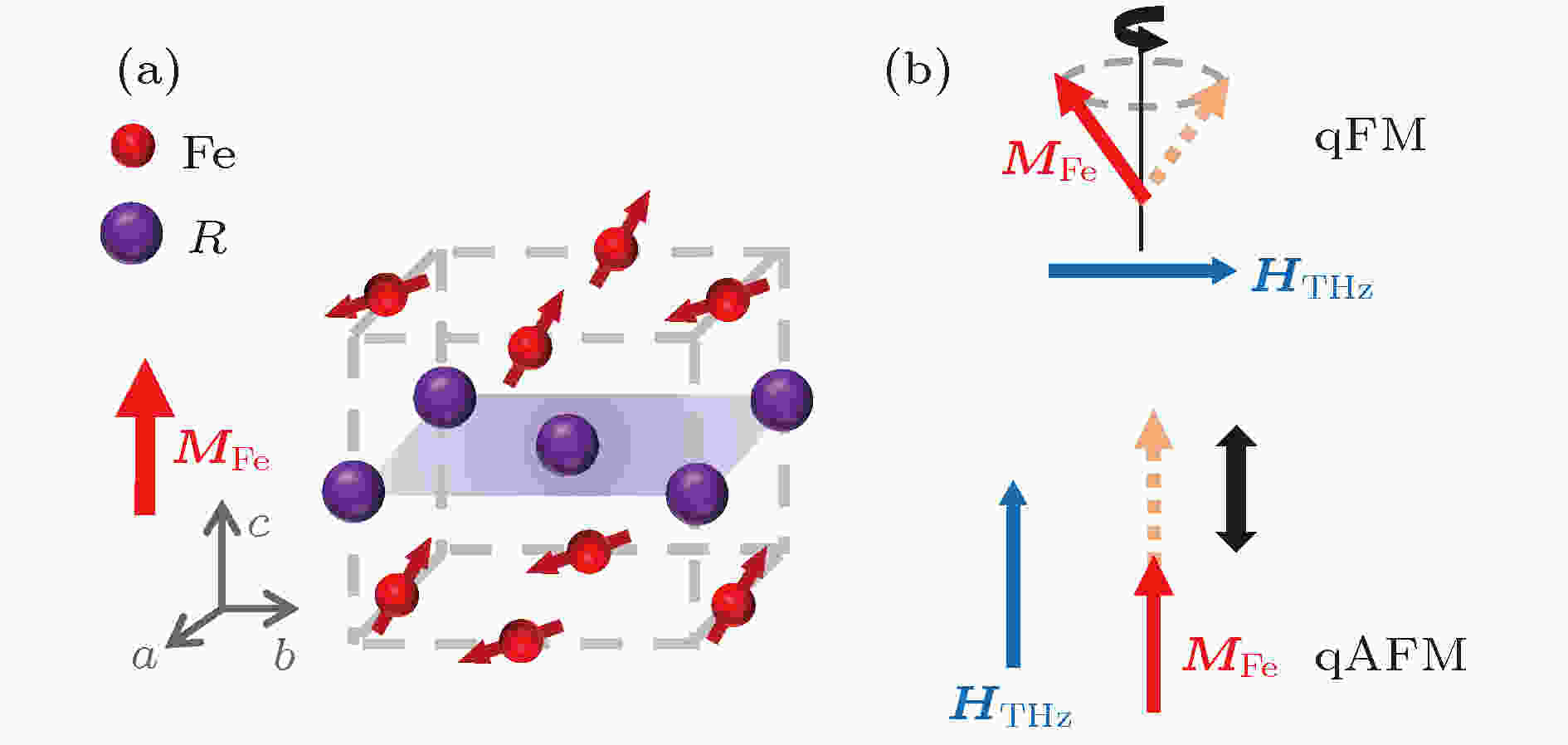
2019, 68 (16): 167501.
doi: 10.7498/aps.68.20190706
Abstract +
Antiferromagnets (AFM) are promising for future spintronic applications due to their advantageous properties. Antiferromagnets produce no stray fields and are insensitive to external magnetic field perturbations. Furthermore, antiferromagnets show intrinsic high terahertz (THz) frequency dynamics. The THz pulses are a direct and general probe of ultrafast spin dynamics in insulating antiferromagnets. In this review article, we discuss the excitation and control of the antiferromagnetic spin resonances in rare-earth orthoferrites (RFeO3, R indicates Y and rare-earth element) with the THz electromagnetic pulsetime-domain spectroscopy. We believe that this approach is general and can be applied to a broad range of materials with different AFM spin alignments, giving a novel non-contact approach to probing AFM order with ps temporal resolution. We summarize different quasi-ferromagnetic modes (qFM) and quasi-antiferromagnetic modes (qAFM), as well as the spin reorientation transition temperatures of RFeO3. Coherent control of spin waves at THz frequency promises fruitful applications in ultrafast magnetization control and has received increasing attention. It is demonstrated that not only the delay time between the excitation and control THz pulses arriving DyFeO3, but also the intrinsic dielectric anisotropy of YFeO3 in the THz range allow the coherent control of both the amplitude and the phase of the excited spin waves. Moreover, we outline the current observation of Dicke cooperativity in magnetic interaction of ErxY1-xFeO3, which presents a route to understanding, controlling, and predicting novel phases of condensed matter by using the concepts and tools available in quantum optics. Finally, magnon-polaritonsare demonstrated to play a key role in preparing the THz waves through TmFeO3.

2019, 68 (16): 167801.
doi: 10.7498/aps.68.20190459
Abstract +
The ternary compound aluminum gallium arsenide is an important material that can be used in all-optical solid-state ultrafast diagnostic technology. The low-temperature-epitaxially-grown AlGaAs (LT-AlGaAs) not only has the characteristics of ultra-short carrier lifetime of low-temperature-grown gallium arsenide (LT-GaAs), but also possesses the advantage of adjustability of band gap, which will provide great flexibility for the design of ultra-fast diagnostic systems. We use low-temperature epitaxial growth technology to grow AlGaAs on a GaAs substrate. The low-temperature-grown AlGaAs can effectively absorb 400 nm pump light to generate excess carrier. Therefore, we use a femtosecond laser with a wavelength of 800 nm and a pulse width of 200 fs as a light source to generate 400-nm pump light after passing through the BBO crystal, and 800 nm light without frequency doubling as the probe light. Using such a light source, we build a pump probe experimental platform to test the LT-AlGaAs. We normalize the experimental results and deconvolute it with the normalized laser pulses to obtain the response function of the semiconductor to the pump light. Therefore, we know that the nonequilibrium carrier relaxation time is less than 300 fs, and the nonequilibrium carrier recombination time is 2.08 ps. Due to the special passivation process, the effect of surface recombination on the carrier decay process is greatly reduced. The As clusters introduced by low-temperature epitaxial growth form deep level defects are the main factor for accelerating carrier recombination. In order to understand the complex process of photogenerated nonequilibrium carriers in depth, we use the indirect recombination theory of single recombination center to calculate the carrier recombination process, and establish an LT-AlGaAs carrier evolution model. Thus we obtain the key physical parameter related to the recombination rate, which is the carrier trapping area. We also use a theoretical model of carrier-regulated refractive index to calculate the effect of carrier concentration on the amount of change in refractive index. Combining our AlGaAs carrier evolution model, we simulate the refractive index change process of LT-AlGaAs after being illuminated by pump light. The simulation results are in good agreement with the experimental results. The method can be used for the quantitative analysis of carrier evolution characteristics of semiconductor materials, and it can conduce to the optimization and improvement of ultra-fast response semiconductor materials.
GENERAL

2019, 68 (16): 160201.
doi: 10.7498/aps.68.20190379
Abstract +
We numerically calculate Luttinger liquid parameter K in the anisotropic spin XXZD models with spin $s = 1/2$ , 1, and 2. In order to obtain groundstate wavefunctions in Luttinger liquid phases, we employ the $U(1)$ symmetric infinite matrix product states algorithm (iMPS). By using relation between the bipartite quantum fluctuations F and the so-called finite-entanglement scaling exponents $\kappa$ , the Luttinger liquid parameter K can be extracted. For $s = 1/2$ and $D=0$ , the numerically extracted Luttinger liquid parameter K is shown to be good agreement with the exact value. On using the fact that the spin-1 XXZD Hamiltonian with $ D \leqslant - 2$ can be mapped to an effective spin-1/2 XXZ model, we calculate the Luttinger liquid parameter for the region of $ D \leqslant - 2$ . It is shown that our numerical value of the Luttinger liquid parameter agree well with the exact values, here, the relative error less than $1\%$ . Also, our Luttinger liquid parameter at $\Delta = - 0.5$ and $ D = 0$ is shown to be consistent with the result form the density matrix renormalization group (DMRG) method. These results suggest that the $U(1)$ symmetric iMPS method can be applicable to calculate Luttinger liquid parameters if any system has a $U(1)$ symmetry for gapless phases. For instance, we present our Luttinger liquid parameters for the first time for the spin-1 XXZD model under the other parameters and the spin-2 XXZD model with $D = 1.5$ .
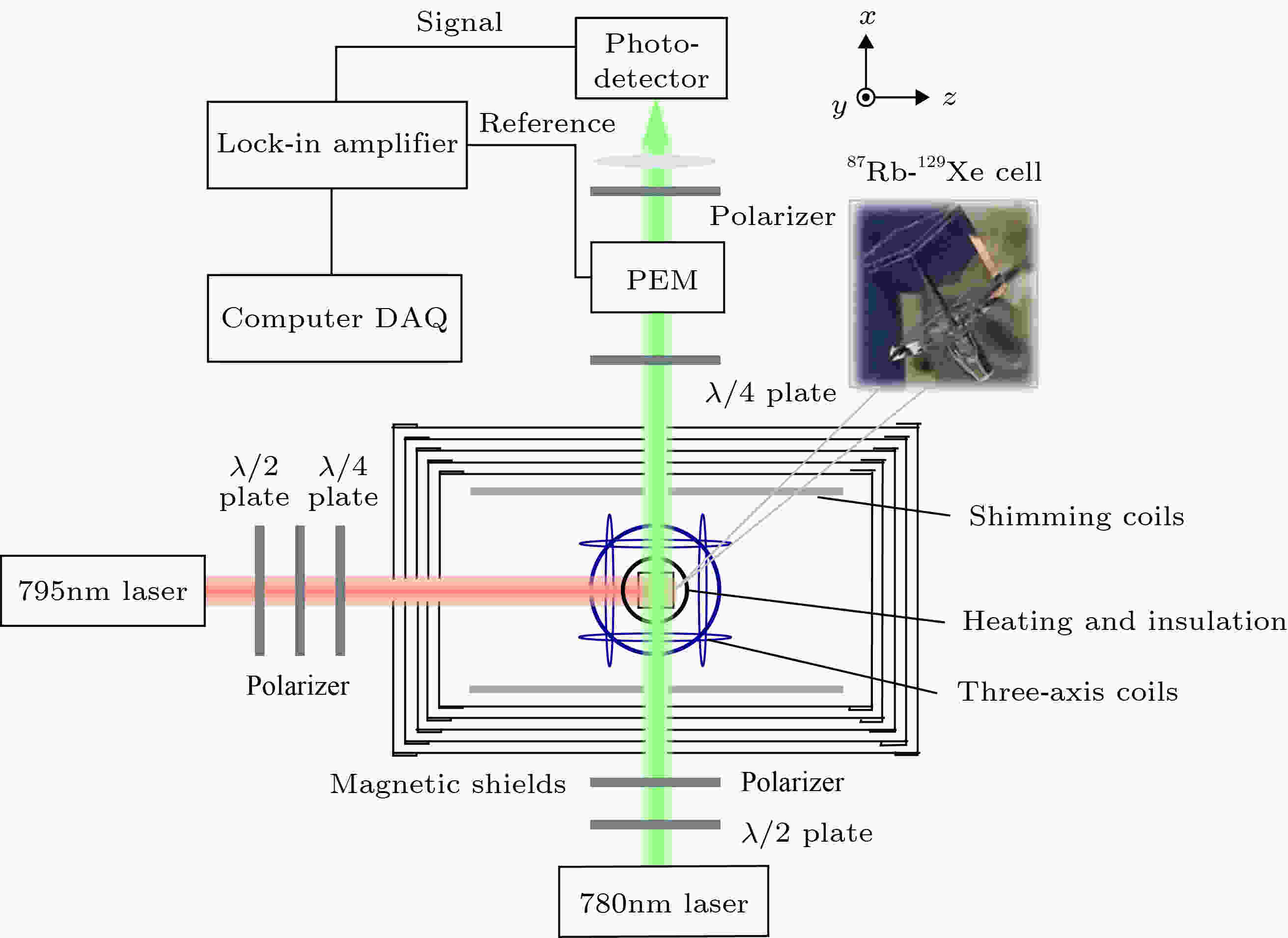
EDITOR'S SUGGESTION
2019, 68 (16): 160701.
doi: 10.7498/aps.68.20190868
Abstract +

COVER ARTICLE
2019, 68 (16): 160702.
doi: 10.7498/aps.68.20190709
Abstract +
X-ray focusing telescope is one of the most important equipment for X-ray space observation, which is designed based on the grazing incidence principle. The purpose of x-ray observation is to detect the black holes of various sizes in outer space, and the data obtained by X-ray telescope conduces to investigating the basic physical law under the condition of extreme gravity and magnetic field, In this article, multi-layer telescope is designed to satisfy the demand for enhanced X-ray timing and polarimetry mission. in which the telescope is designed based on Wolter-I telescope. The Monte Carlo method and power spectral density are used when the relationship between mirror profile and roughness with angular resolution is investigated. We analyze the relationship between angular resolution and mirror profile, and the result shows that the higher mirror profile possesses higher angular resolution. When the root mean square(RMS) of mirror profile is 0.04 μm, PV is 0.2 μm and roughness is 0.4 nm, the mirror angular resolution is 6.3" and it will change to 30.6" when the RMS of mirror profile is 0.2 μm, PV is 1 μm and roughness is 0.4 nm. The angular resolution out of focus is also investigated in this article, and the more defocusing amount gives rise to the worse angular resolution because defocusing spot will be larger than that of focal plane. So the maximum defocusing amount of 5 mm is required when the focal plane detector is installed. The relationship between effective area with film structure and layers number is also investigated. The film with Au mixed with C has a higher reflectivity than the film with only Au, because the mixed film will generate an interference effect and enhance the intensity of reflecting X-ray. When the telescope layers increase, the effective area and telescope weight are both improved, the requirement for effective area of satellite can be satisfied when the number of nesting layers is 45. However, when the number of nesting layers further increase, the effective area will be improved with a low speed, but the weight of telescope will increase with a high speed. The field of view of this telescope is 16′, which is more than the required value of 12′. Finally, the X-ray focusing telescope with 5.25 m focal length, 45 nesting layers, effective area 842 cm2 at 2 keV, 563 cm2 at 6 keV is obtained.
THE PHYSICS OF ELEMENTARY PARTICLES AND FIELDS
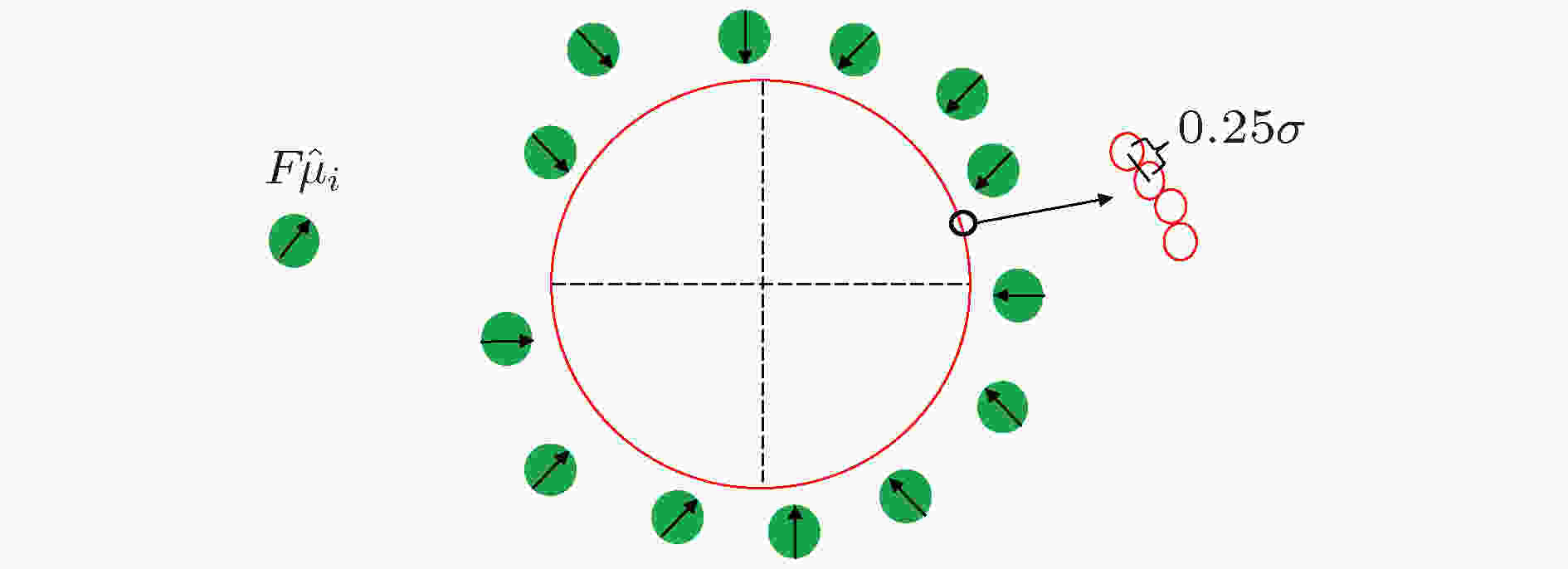
2019, 68 (16): 161101.
doi: 10.7498/aps.68.20190425
Abstract +
Self-propelling motionisubiquitous in the biological world, ranging from the molecular-level transportation of motor proteins along the microtubules, to the swimming of bacteria on a micrometer scale. An intriguing topic is to design microdevices or micromotors that can rectify the random motion and convert the energy into mechanical work. Here we design a soft microdevice, which may possess the advantages such as damage resistance, durability and adaptability, by utilizing two-dimensional Langevin dynamics simulation. We use a flexible chain to mimic the soft boundary of microdevice. We investigate the dynamical behaviors of microdevice when it is immersed in a thin film of active particle suspension. We find that the microdevicecan rotateunidirectionally and hence output the work. To uncover the physical mechanism of unidirectional rotation, we calculate the pressure distribution along the soft boundary. The spontaneous symmetry breaking of flexible boundary is the origin of the unidirectional rotation, which can lead to the inhomogeneous pressure distribution and hence torque on ratchet. It is because the persistent motion drives the particles to accumulate near the boundary and induce the soft boundary to deform. Further, we focus on the effect of active force and particle density on the angular velocity. With the increase of active force, the average angular velocity increases monotonically due to the increase of torque. With the increase of the number density of active particles, the average angular velocity increases. This is because the aggregation of a large number of particles is beneficial to the increase of ratchet torque. Additionally, we pay attention to the effect of rotational diffusion rate, Dr, of active particles and the number of ratchet wheels. We find the average angular velocity decreases with the increase of rotation diffusion Dr because ofthe ability of particles to weakly accumulate at high Drs. The average angular velocity also decreases with the increase of the number of ratchet wheels. This is because a large number of ratchet wheels weaken the asymmetry of pressure distribution and hence reduce the torque on wheel. Our work provides a new insight into the design of soft microdevices for studying the non-equilibrium system.
ELECTROMAGNETISM, OPTICS, ACOUSTICS, HEAT TRANSFER, CLASSICAL MECHANICS, AND FLUID DYNAMICS

2019, 68 (16): 164201.
doi: 10.7498/aps.68.20190243
Abstract +
An NO2 sensor based on a fiber coupled broadband LED source with a Herriott multi-pass cell is developed and demonstrated for calibrating aerosol absorption photoacoustic (PA) spectrometer. At first, a Herriott multi-pass cell with an effective optical path of 26.1 m is designed based on the theory of light transmission, for increasing the light absorption of NO2 in the cell. It is difficult to obtain a high-quality beam of LED by using the conventional collimating method that enables the collimated output beam to transmit back and forth in the multi-pass cell, due to the large emitting surface and divergence angle of the LED. So, in the present work, the emission of the LED is coupled into a single model fiber, and then collimated by using a lens. The LED spectrum does not change before and after fiber coupling. The collimated beam with a central wavelength of 438.5 nm is coupled into the multi-pass cell. The output beam passing through the multi-pass cell is detected by using a spectrometer for retrieving the NO2 concentration. Finally, an expected concentration detection limit of 1 μmol/mol (3σ) is achieved within 1 s acquisition time and the signal-to-noise ratio (SNR) is 40. By analyzing the result measured with 46 μmol/mol NO2, a measurement precision of 0.1% is achieved. In order to calibrate the aerosol absorption PA spectrometer, the NO2 sensor and the aerosol absorption PA spectrometer based on 450 nm are used to measure different concentrations of NO2, simultaneously. The results show that the measured NO2 concentration has a good linear relationship with the PA spectrum signal, and the linearity is better than 99.9%. This good linear relationship further shows the feasibility and reliability of the NO2 sensor. The slope of calibration curve after normalizing the power is 0.95 nV/(mW·Mm-1). Using this calibration result, the PA signal measured with aerosol absorption PA spectrometer is transformed into the absorption coefficient. The developed NO2 measuring system based on a broadband LED light source and Herriott multi-pass cell has the advantages of low cost, simple structure and easy use. It can be used to calibrate the aerosol absorption PA spectrometer, and also to measure NO2 in industry.

2019, 68 (16): 164202.
doi: 10.7498/aps.68.20190429
Abstract +
Acquisition, tracking and pointing (ATP) is an important subsystem of satellite-based optical communication system. It controls the direction of the beam passing through the mirror, and then completes the alignment and stabilization of intersatellite/satellite-ground light path. As is well known, the ordinary mirror changes the polarization of photons, so the ATP mirrors must be specially processed in quantum communication system and coherent optical communication system. For example, in order to counteract the change of photon polarization caused by the mirror, it is usually necessary to coat the mirror. However, this membrane structure must be tested by the radiation and temperature change from the space environment. A polarization-independent reflector based on two magneto-optical crystals and two mirrors is proposed. This structure does not need any special treatment (such as coating) for the reflector. It can realize polarization-independent reflection at any angle only through the reasonable configuration of the ordinary reflector and 90° rotatory crystal. In addition, it is found that the structure has self-stability, that is, when the polarization characteristics of optical devices change due to environmental change, the overall polarization reflection characteristics of the reflective structure remain unchanged. The polarization equation of reflected light of reflector based on two magneto-optical crystal and two mirrors is derived. The polarization of reflected light under environmental influence is simulated, and the polarization independent reflection self-stability of double-rotating double-reflection structure is found. The polarization-independent self-stabilization of this structure is verified by temperature and radiation experiment. The experimental results show that the average polarization retention of the reflecting light of the reflector based on two magneto-optical crystal and two mirrors can reach 99.77% when the temperature varies from -45 ℃ to 85 ℃. The mirrors and the magneto-optical crystals are irradiated by cobalt 60 with a total dose of 400 Gy, and the average polarization retention of the reflective structure is also 99.35%. The experimental results show that the polarization-independent reflectance can be kept stable for a long time in the space environment where radiation and temperature change dramatically. Relying on this self-stability, the reflector based on two magneto-optical crystals and two mirrors can maintain high polarization-independent reflection capability for a long time in a space environment. This makes it a new option for polarization-preserving reflective components in satellite-based optical communication systems.

2019, 68 (16): 164203.
doi: 10.7498/aps.68.20190161
Abstract +

2019, 68 (16): 164204.
doi: 10.7498/aps.68.20190744
Abstract +
Semiconductor laser is one of the most critical components in the field of modern communication. Research and development of single-mode semiconductor laser with high stability, high power, high beam quality and narrow line width is an important research area in this field. In this paper, A novel edge-emitting semiconductor laser diode structure is proposed. In the structure an active multimode interference waveguide structure serves as a main gain region. To modulate the longitudinal mode of the laser, a gain-coupled distributed feedback(DFB) laser based on high order surface gain coupled grating is introduced into the structure as well. The novel structure is then fabricated and compared with an conventional DFB laser. The experimental results show that higher slope efficiency and output power are achieved with the proposed structure than those with the conventional distributed feedback semiconductor lasers. The novel structure is also compared with conventional MMI laser with only Fabry-Parot(FP) cavity. The result shows that the proposed structure has higher beam quality and better stability than the FP cavity multimode interference waveguide lasers. To enhance the gain contrast in the quantum wells without introducing the effective index-coupled effect, the groove length and depth are well designed. Our device provides a single longitudinal mode with the maximum CW output power up to 53.8 mW/facet at 981.21 nm and 400 mA without facet coating, 3 dB linewidth < 13.6 pm, and SMSR > 32 dB. Optical bistable characteristic is observed with a threshold current difference. Meanwhile, by using high-order distribution feedback grating formed by shallow surface etching in the process of chip design and fabrication, the proposed structure of laser diode can realize regrowth freely and only micron-scale precision i-line lithography is required. Such a structure with simple fabrication process and low manufacturing cost has great potential for commercial mass production.

2019, 68 (16): 164205.
doi: 10.7498/aps.68.20190268
Abstract +
In this paper, we present a novel method of computing tomography , i.e. the low third deviation total variation (LTD-TV) method to reconstruct the two-dimensional distribution of SO2 of stack plume. The path-integral data of the plume are collected by only two imaging differential absorption spectrometers (IDOASs). However, due to the insufficient number of IDOASs, conventional reconstruction methods result in severe streaking artifacts. The traditional low third derivative method is widely used to reconstruct the gas distribution. It suggests a spatial distribution of gas concentrations, which has a low third spatial derivative in every direction and at every point. The derivatives are usually set to be zero. The method improves the reconstructed images by providing extra information which contains the gas concentration in line with the distribution of the second order polynomial, but it also gives rise to the extra artifacts. To address this issue, we further improve the traditional low third deviation (LTD) method by suggesting that the third derivative of gas concentration is sparse. We therefore adopt the compressed sensing (CS) based total variation (TV) optimization framework. In the LTD-TV method, a logarithmic barrier function with TV is used as an objective function. The objective function is then optimized by numerical optimization method, in which the gradient projection is used to determine its descent direction and a Barzilai-Borwein scheme to determine its step-size. The final results are obtained by iterative optimization. Numerical simulations are performed to simulate the reconstruction of gas distribution which is in line with Gaussian distribution. Compared with the conventional LTD method, the LTD-TV method enhances the proximity by 20%—80%, and greatly corrects the artifacts near the edges of images. The result of field campaign suggests that concordance correlation factor between the collected data and reconstructed image is 0.9023. It also shows that it has good noise immunity. In summary, it is the first time that we have introduced the CS theory into the field of gas plume reconstruction. Compared with the existing methods, the LTD-TV method can greatly reduce the artifacts and increase the credibility of the reconstruction.
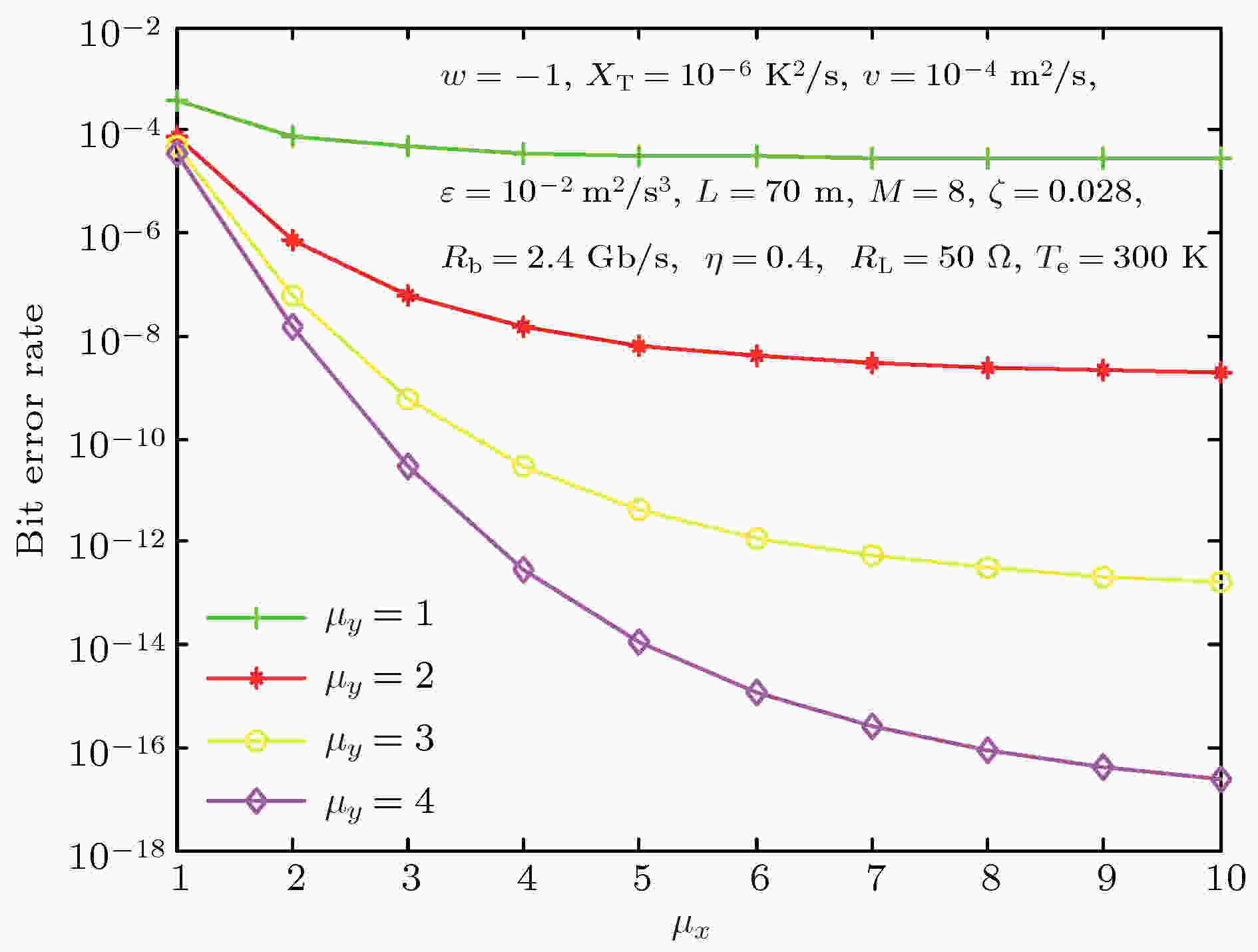
2019, 68 (16): 164206.
doi: 10.7498/aps.68.20190452
Abstract +
Pulse position modulation (PPM) technology combined with the system of wireless optical communication received by the photon detector has the advantages of high energy efficiency and strong anti-interference capability. This technology has received extensive attention in the field of underwater wireless optical communication (UWOC) system. Affected by ocean turbulence, the UWOC system will produce the intensity fluctuations, leading the system performance to degrade. The Gamma-gamma intensity fluctuation probability model, which is a two-parameter model, possesses a wide range of applications. It can describe weak, medium and strong fluctuation in light intensity statistics. In this paper, firstly, based on the relationship between the weak atmospheric turbulent spherical wave scintillation index and the weak ocean anisotropic turbulent spherical wave scintillation index, the equivalent structural parameter expressed by both ocean turbulence parameters and anisotropy factor is derived. Then, using the structural parameter combined with the gamma-gamma turbulence channel and the asymptotic Rytov theory, the bit error rate (BER) under anisotropic ocean turbulence is calculated based on the BER formula of the PPM communication system. Finally, numerical simulations are carried out to analyze the ocean turbulence parameters, the average avalanche photodiode (APD) gain, the PPM modulation order, the data bit rate, and the influences of transmission distance on the BER under different anisotropic ocean turbulences. The results indicate that the negative effect of turbulence becomes stronger with increasing the ratio between the contributions of temperature and salinity to the refractive index spectrum, the dissipation rate of mean-squared temperature, data bit rate, and propagation distance. As the viscosity coefficient increases, the BER decreases. When the isotropic ocean turbulence and the anisotropy factors are very small, the increase of the rate of dissipation of kinetic energy per unit mass of fluid will result in a decrease in BER. When the turbulent environment anisotropy is further strengthened, the BER first increases and then decreases as the rate of dissipation of kinetic energy per unit mass of fluid increases. As the average APD gain increases, the BER first decreases and then increases. This trend is especially noticeable as the anisotropy factor increases. The choice of the average APD gain is important for finding the minimum value of the BER. In general, the system is more affected by salinity fluctuation than by temperature fluctuation. As the rate of dissipation of mean-squared temperature increases and the viscosity coefficient decreases, the negative effects of turbulence becomes more and more serious. When the system propagates longer distances or works at a higher data bit rate, the system is severely affected by turbulence, which limits the system operating distance and data transmission rate. However, using a smaller modulation order and choosing the right APD can conduce to improving the system performance. In addition, the PPM UWOC system can perform better when the system operates within acceptable bit error rate as the ocean turbulence environment becomes more anisotropic. This study will provide reference for the construction and performance estimation of UWOC system platform.

2019, 68 (16): 164701.
doi: 10.7498/aps.68.20190323
Abstract +
The Grossman and Lohse (GL) theory is an important theory for studying the heat transfer characteristics of the turbulent convection. Previous computational studies have found that when the Ra number is higher than a certain value, the change of the heat transfer Nu number with Ra number in two-dimensional turbulent thermal convection is different from that in the three-dimensional thermal convection, deviating from the multiples line of the GL theory prediction. Therefore, the value of studying the two-dimensional numerical calculation of turbulent thermal convection with high Ra number is questioned. The numerical calculations of a series of two-dimensional turbulent thermal convection events with high and very high Ra number(specifically, maximum Ra = 1013 with Pr = 0.7 and 4.3) are carried out in this paper. The results show that there exists a good correlation between the heat transfer Nu number and the variation of large scale circulation path length(that reflects the plume motion) with Ra number in the two-dimensional turbulent convection, and they have two Ra number transition points. The first transition point appears in the large scale circulation from the ellipse to the circle, when its circumference CLSC of the large scale circulation suddenly decreases with Ra number increasing. The second transition point appears at the minimum circumference CLSC, and then the plume rheology becomes vortex group and the circumference CLSC increases with Ra number increasing. The Ra number at transition point for a smaller Pr number is lower. The variation of the heat transfer Nu number after Ra0.3 compensation shows that the local scale law of Nu number decreases as the circumference CLSC of the large scale circulation becomes small, and a phenomenon of deviating from the multiples line of GL theory prediction appears. When Ra number is higher than the second transition point, the local scale law of the Nu number varying with Ra number is in good agreement with the multiples line of GL theory prediction again in 2D turbulent thermal convection. It means that the numerical results of two-dimensional turbulent thermal convection can correctly reflect the heat transfer characteristics of turbulent thermal convection under the condition of very high Ra number.
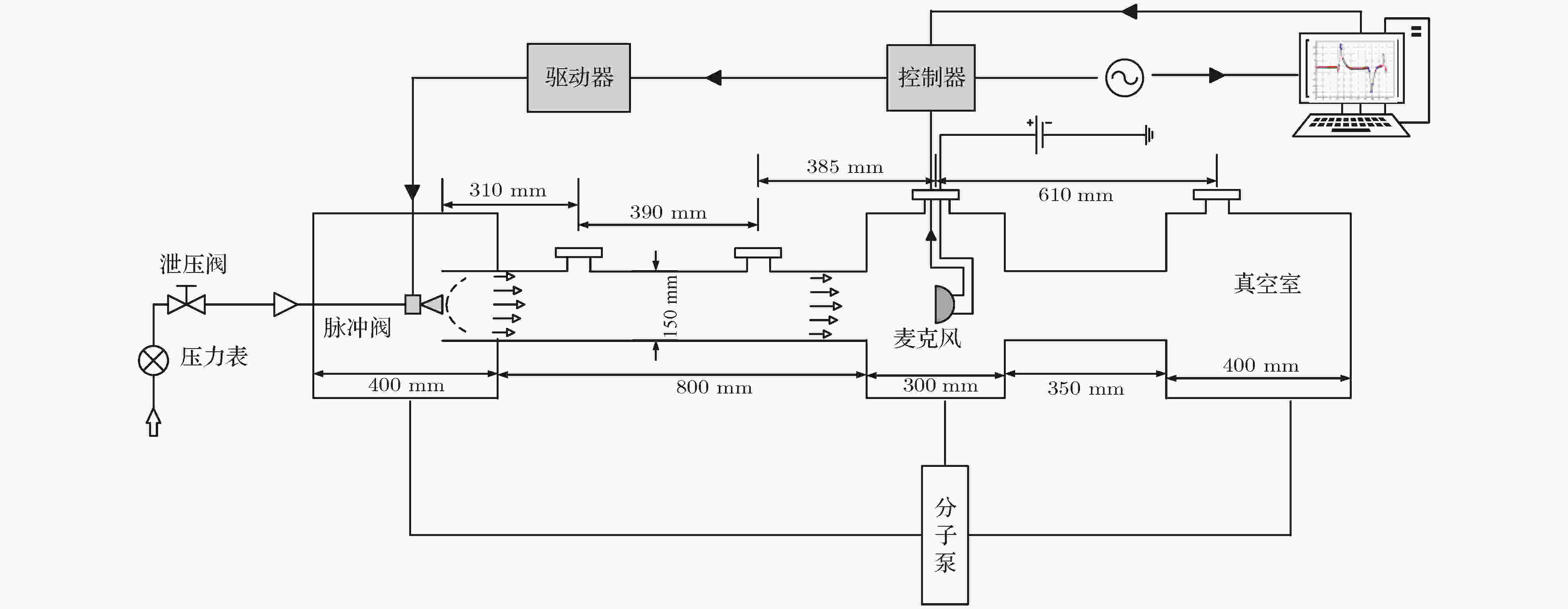
2019, 68 (16): 164702.
doi: 10.7498/aps.68.20190436
Abstract +
The expansion and transportation of supersonic molecular beams is a complex process of molecular dynamics, and the related parameters are difficult to calculate accurately. Currently there is no rigorous theory to accurately predict the beam expansion process under specific valve conditions, and current researches are less concerned with the spatial evolution of supersonic molecular beam characteristics over long distance. In addition, time-of-flight mass spectrometry is not well suitable for supersonic molecular beam injection in the field of magnetic confinement fusion. Therefore, based on microphone measurements, the average velocities of several supersonic molecular beams (H2, D2, N2, Ar, He, CH4) in the process of free expansion and their evolutions in the far-field space (flight distance/nozzle diameter > 310) are studied in this work. The variations of velocity distribution with gas type, temperature, pressure and expansion distance are obtained. The results show that the velocities of H2, D2 and He beams account for only 54%, 60% and 68% of their ideal limit velocities, respectively, and their velocities decrease rapidly in the far-field space. The velocities of CH4, N2 and Ar beams are very close to their limit velocities, accounting for 85%, 92% and 99% respectively, and their velocities decrease slowly in the far-field space. And the results show that the velocities of the H2 and D2 beams increase with the source pressure, while the velocities of the other four molecular beams decrease slightly with the source pressure. And it is found that the velocity of supersonic beam without skimmer is negatively correlated with the square root of the molecular mass. For the effect of temperature on velocity, the results show that the velocities of H2 and D2 beams increase with the source temperature but are smaller than their limit velocities at given temperature, and the difference is larger for higher temperature. The results of this experiment provide basic data for controlling the parameters of the supersonic molecular beam by adjusting the temperature and pressure of the gas source, which will contribute to the application of supersonic molecular beams in fusion reactor fueling technology. And this study will contribute to further exploration of the evolution of supersonic molecular beam properties in the far-field space.

Analysis of dynamic characteristics of two-component granular mixture segregation in thin shear cell
2019, 68 (16): 164703.
doi: 10.7498/aps.68.20190322
Abstract +
Particle separation is important in industrial production. The granular powder exhibits the property that is like both fluid property and solid property, which makes it difficult to establish a mathematical model to reveal the particle motion mechanism. The fluid property of the granular powder can be partly explained by the classical fluid theory, but the solid property cannot be covered. Theories combining the fluid and solid properties are also used to explain the particle separation phenomenon. However, they are not in consensus about the granular theory to explain the particle separation mechanism. Friction dissipation, which represents the particle pairwise damp interactions, greatly influences the particle separation process. In order to understand the particle separation mechanism and the effect of friction coefficient on the particle motion, a three-dimensional discrete element model is used to simulate the separation of three-dimensional spherical binary particles in a cylindrical groove (shear cell)in this paper. Initially, the large particle is placed at the bottom and the other small particles pile into the groove. The shear flow of the particles is established by rotating the bottom plate of the groove. The large particles gradually jump to the top of the groove under the shearing action. The effect of particle friction coefficient on the separation is studied. Focusing on the characteristics of kinematics and dynamics in the jumping process of large particle, the influence of the friction coefficient on the trajectory, velocity and acceleration of particle are quantitatively analyzed. The conclusions are obtained as follows. 1) The process of large particle jumping can be divided into three stages: relaxation stage (the large particle stays at the bottom of the groove), the take-off stage (the large particle rises up), and the equilibrium stage(the large particle moves to the top and stays there). 2) The relaxation time decreases with friction coefficient increasing. 3) The equilibrium height of particles increases with friction coefficient increasing. 4) The amplitude of the force pulsation of the large particle increases with friction coefficient increasing. For the behavior analysis of the ascending motion of the large particle, we propose a neighborhood analysis method and define a floating factor. The ratio of the number of small particles arranged in the upper to that in the lower adjacent space of the large particle is defined as the buoyancy factor. It is found that the buoyancy factor drops sharply at the jumping point of the large particle, forming the opportunity for the large particle jumping. It is revealed that the take-off of the large particle is the result of both the high-frequency characteristics of force fluctuation and the steep drop of buoyancy factor. The rising motion of the big particle is determined by the force and the surrounding space.
PHYSICS OF GASES, PLASMAS, AND ELECTRIC DISCHARGES

2019, 68 (16): 165201.
doi: 10.7498/aps.68.20190410
Abstract +
Based on magnetohydrodynamics(MHD), the evolution of the Richtmyer-Meshkov instability in different magnetic field configurations are studied. To ensure the zero magnetic divergence, an unsplit integration algorithm is adopted by combining corner transport upwind and constrained transport (CTU+CT) algorithm. The second order Godunov flux is obtained by using piecewise parabolic method(PPM) to construct conserved variables. The numerical results show that the evolution of complex wave patterns is not affected by magnetic fields, but the interface instability is compressed by magnetic field, especially in the case of transverse magnetic fields. Specifically, whether there exists magnetic field or not, irregular reflections occur outside the cylinder. Meanwhile, the central part of incident shock wave interacts with the density interface and generates the transmitted shock wave. Subsequently, the transmitted shock wave oscillates back and forth inside the cylinder, forming a transmission-reflection structure multiple times. Besides, in the absence of magnetic field, the density interface rolls up with a series of vortex sequences and an SF6 jet surrounded by vortex pairs appears. Then the SF6 jet passes through the downstream interface. In a longitudinal magnetic field, although density interface is smooth, a few vortex sequences still exist in the downstream interface and SF6 jet can still pass through downstream interface. However, in the case of transverse magnetic field, the interface is much smoother than in the other cases and the SF6 jet cannot pass through the downstream interface. The quantitative study also indicate that the increase of characteristic sizes is suppressed by the magnetic field. In addition, because of the influence of Richtmyer-Meshkov instability, magnetic lines are distorted near density interfaces. More distortions can be observed in the upstream interfaces, resulting in strong Lorentz forces in that area, which leads to the long distance between two vortex sheets distributed along two sides of the interface. In the downstream interfaces Lorentz forces are rather small, but the forces are even smaller in the longitudinal magnetic field, as a result vortex sheets interact with each other in that area. Furthermore, the dynamic mode decomposition(DMD) is primarily used in this paper and the results illustrate that even controlled by magnetic fields, vortex sequences can still exist, especially in the case of longitudinal magnetic field. For all cases, the first DMD modes all illustrate that a stable mode is the dominated feature of fluid field, and the following second to fourth mode show that the strength of vortex sequences decreases while their frequencies increase continually. Besides, for the same modes, the frequency of vortex sequences is reduced by magnetic fields, especially by the transverse magnetic field.

2019, 68 (16): 165202.
doi: 10.7498/aps.68.20190522
Abstract +
Broadband very-high frequency (VHF) localization of lightning radiation sources provides an important means for understanding lightning discharge characteristics and the corresponding physical mechanisms. In order to improve the ability to locate weak radiation sources, the orthogonal propagator method (OPM) is proposed to map the space-time evolution process of lightning discharge channels based on the theory of spatial spectrum estimation. In the method, the linear decomposition of the covariance matrix is used to form the orthogonal propagator, and the spatial spectrum is constructed according to orthogonality of subspaces. Then, the location of lightning radiation sources is determined by searching for the maximum of the spatial spectrum. For broadband VHF signals, the non-coherent subspace method is used to average the effective frequency points in bandwidth to reduce noise interference. Based on a multiple-antenna radiation continuous observation system (MARCOS), locating performance of the method is analyzed by numerical simulation. The method is verified by parameters such as locating error, half-peak width of the spatial spectrum, and angular resolution. Compared with the results from the time reversal technique(FDTR), the location error and recognition probability under a low signal to noise ratio (SNR) of the proposed OPM algorithm are similar to those of FDTR algorithm, but the angular resolution for two radiation sources of OPM algorithm is better than that of FDTR algorithm. Finally, the proposed method is used to map the spatial and temporal development of a classical triggered lightning discharge channels in the summer of 2017. The results show that the proposed method can clearly depict the basic structure of lightning discharge channels with high spatial and temporal resolution. For the upward positive leader of the triggered lightning, the OPM algorithm can locate more radiation sources with a better structure than the FDTR algorithm. It implies that the proposed OPM algorithm is better for locating weak radiation sources than the FDTR algorithm. Meanwhile, the OPM algorithm has better performance for resolving two radiation sources in the same window than the FDTR algorithm. As a result, the proposed OPM method is of great significance for improving the application value of broadband VHF arrays in the study of locating weak radiation sources and lightning initiation mechanisms.
GEOPHYSICS, ASTRONOMY, AND ASTROPHYSICS

2019, 68 (16): 169101.
doi: 10.7498/aps.68.20182230
Abstract +
As a clean and efficient unconventional energy source, natural gas hydrate has been highly valued and vigorously developed by many countries in recent years. In order to solve the problem that the existing hydrate structure symmetry is not high, which leads the theoretical research to be restricted, it is imperative to explore a new type of methane hydrate structure with high symmetry. Using the first-principles method which is based on the density functional theory (DFT), the structure and electronic properties of N-methane hydrate are calculated in the generalized gradient approximation (GGA) for Grimme dispersion correction. The obtained results are shown below. 1) The water cage structure of N-methane hydrate is a truncated octahedron (4668), which is composed of 8 regular hexagons and 6 squares, and the average length of the hexagons and the average length of the squares are both 2.723 Å. The average bond length of water molecules is optimized to be 1.056 Å, and the average bond angle of water molecules is 107.738°. The average bond length of methane molecules is 1.0973 Å. The average distance from methane molecules to water molecules is 4.2831 Å that is longer than the distance in the I- methane hydrate. So N-methane hydrate can accommodate larger volumes of gas molecules. The symmetric group is ${\rm{IM}}\bar 3{\rm{M}}$ for N-methane hydrate, which has a simple and strict periodic stable structure. 2) The lattice parameter of N-methane hydrate is 7.70 Å, and the density is 0.903 g/cm3, which is greater than I-, II- and H-type hydrate density. 3) The x-ray diffraction(XRD) pattern of N-methane hydrateis calculated and is close to that of of I-methane hydrate, while the water cage of N-methane hydrate is larger. 4) The interaction between methane molecules and the water cage is van der Waals force, and the formation energy of N- methane hydrate is –0.247 eV, which indicates that the N-methane hydrate is easy to form. Both the density of states and partial density of states indicate that the interaction between methane and water cage is weak, and it relies on molecular force. 5) In addition, N-methane hydrate is an insulator material with the energy gap greater than 5 eV.




















